Financial Analysis Report of Woolworths Group Limited
VerifiedAdded on 2023/06/07
|22
|3972
|70
AI Summary
This report is an independent analysis of the financial performance and position of Woolworths Group Limited for the five year period 2013 to 2017. It includes ratio analysis, profitability analysis, liquidity ratios, and overall industry analysis. The report compares the financial performance of Woolworths Group Limited with focus on the profitability indicators, liquidity, efficiency in operations, and financial structure. The report interprets the elements of the financial statement using ratio analysis through evaluation of critical elements in the statements that affect performance in one way or another.
Contribute Materials
Your contribution can guide someone’s learning journey. Share your
documents today.
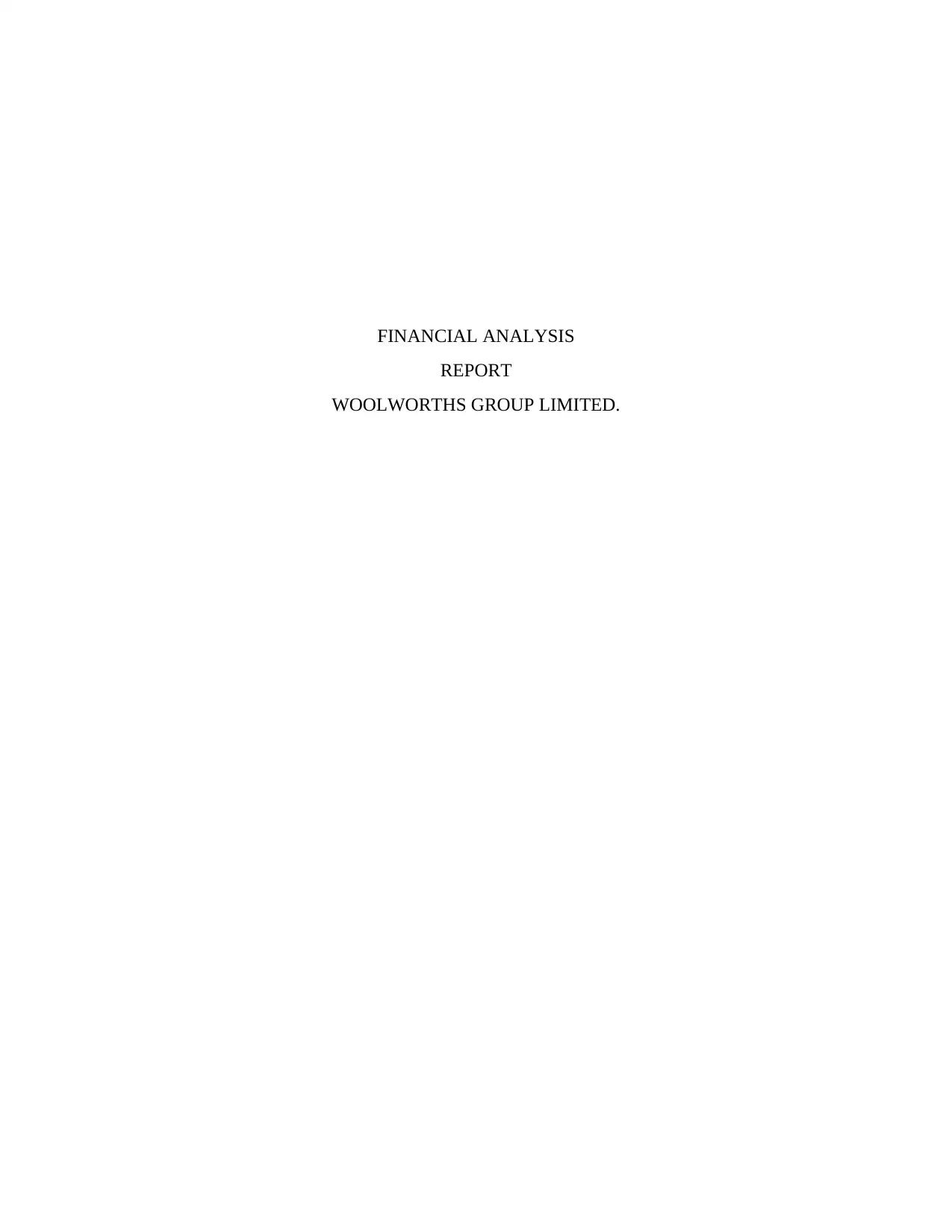
FINANCIAL ANALYSIS
REPORT
WOOLWORTHS GROUP LIMITED.
REPORT
WOOLWORTHS GROUP LIMITED.
Secure Best Marks with AI Grader
Need help grading? Try our AI Grader for instant feedback on your assignments.
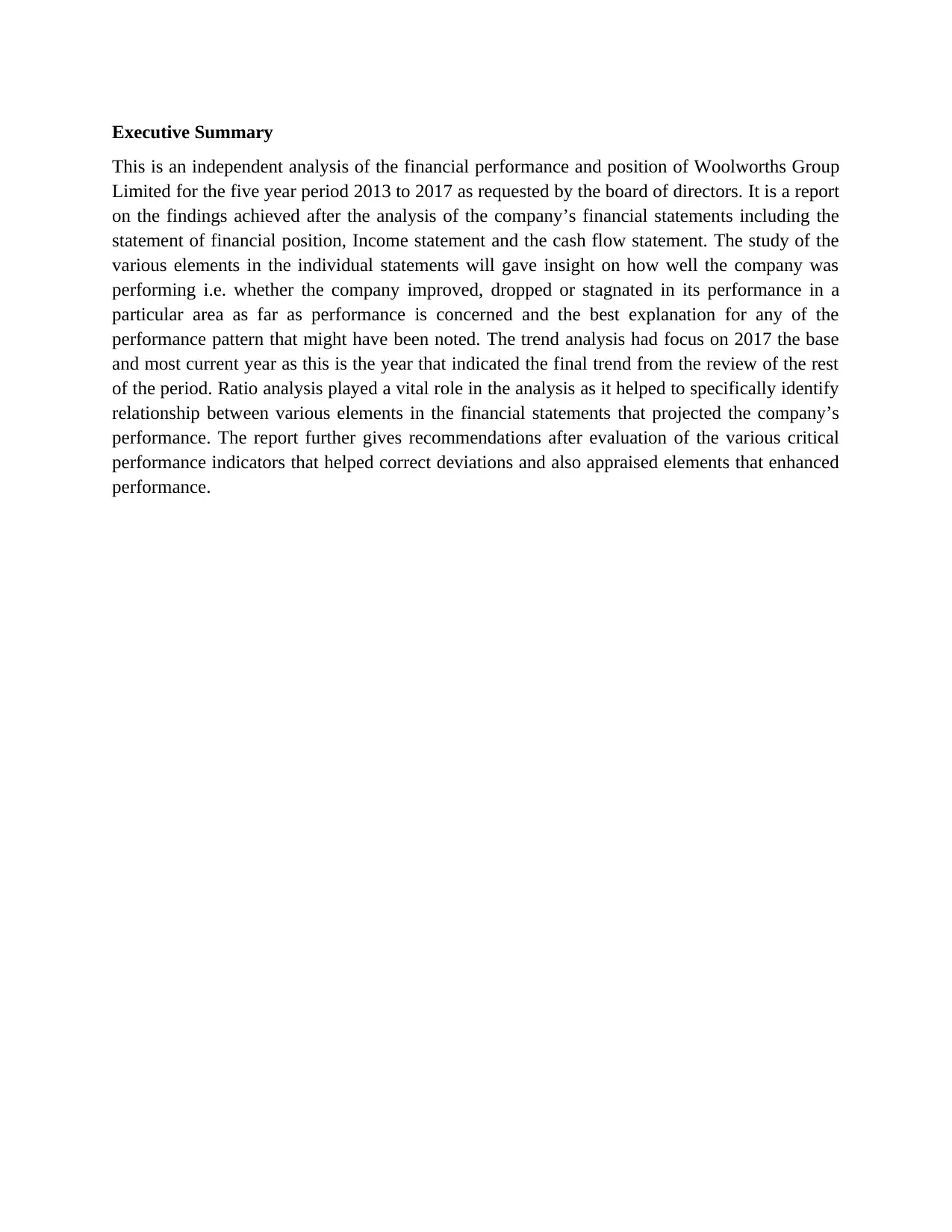
Executive Summary
This is an independent analysis of the financial performance and position of Woolworths Group
Limited for the five year period 2013 to 2017 as requested by the board of directors. It is a report
on the findings achieved after the analysis of the company’s financial statements including the
statement of financial position, Income statement and the cash flow statement. The study of the
various elements in the individual statements will gave insight on how well the company was
performing i.e. whether the company improved, dropped or stagnated in its performance in a
particular area as far as performance is concerned and the best explanation for any of the
performance pattern that might have been noted. The trend analysis had focus on 2017 the base
and most current year as this is the year that indicated the final trend from the review of the rest
of the period. Ratio analysis played a vital role in the analysis as it helped to specifically identify
relationship between various elements in the financial statements that projected the company’s
performance. The report further gives recommendations after evaluation of the various critical
performance indicators that helped correct deviations and also appraised elements that enhanced
performance.
This is an independent analysis of the financial performance and position of Woolworths Group
Limited for the five year period 2013 to 2017 as requested by the board of directors. It is a report
on the findings achieved after the analysis of the company’s financial statements including the
statement of financial position, Income statement and the cash flow statement. The study of the
various elements in the individual statements will gave insight on how well the company was
performing i.e. whether the company improved, dropped or stagnated in its performance in a
particular area as far as performance is concerned and the best explanation for any of the
performance pattern that might have been noted. The trend analysis had focus on 2017 the base
and most current year as this is the year that indicated the final trend from the review of the rest
of the period. Ratio analysis played a vital role in the analysis as it helped to specifically identify
relationship between various elements in the financial statements that projected the company’s
performance. The report further gives recommendations after evaluation of the various critical
performance indicators that helped correct deviations and also appraised elements that enhanced
performance.
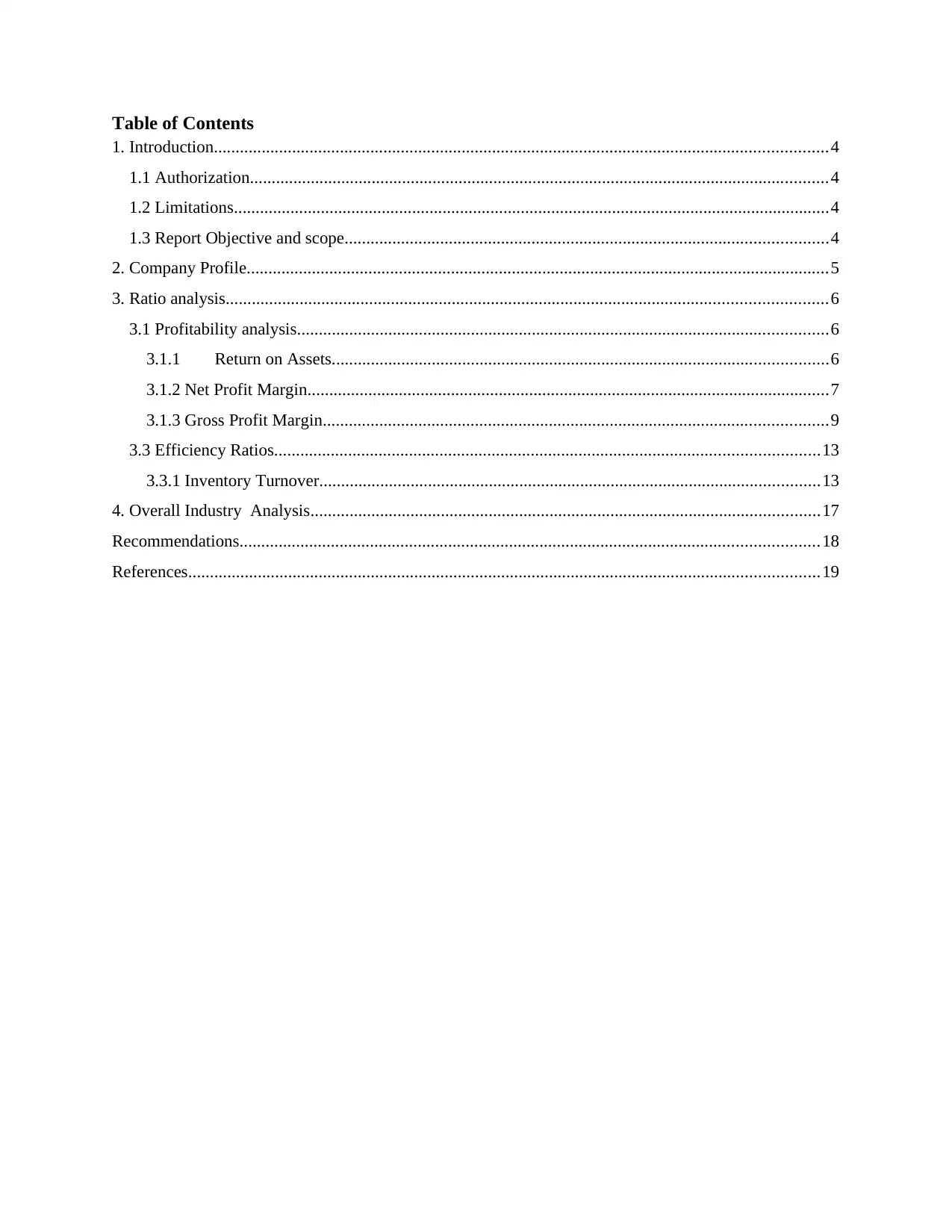
Table of Contents
1. Introduction.............................................................................................................................................4
1.1 Authorization.....................................................................................................................................4
1.2 Limitations.........................................................................................................................................4
1.3 Report Objective and scope...............................................................................................................4
2. Company Profile......................................................................................................................................5
3. Ratio analysis..........................................................................................................................................6
3.1 Profitability analysis..........................................................................................................................6
3.1.1 Return on Assets..................................................................................................................6
3.1.2 Net Profit Margin........................................................................................................................7
3.1.3 Gross Profit Margin....................................................................................................................9
3.3 Efficiency Ratios.............................................................................................................................13
3.3.1 Inventory Turnover...................................................................................................................13
4. Overall Industry Analysis.....................................................................................................................17
Recommendations.....................................................................................................................................18
References.................................................................................................................................................19
1. Introduction.............................................................................................................................................4
1.1 Authorization.....................................................................................................................................4
1.2 Limitations.........................................................................................................................................4
1.3 Report Objective and scope...............................................................................................................4
2. Company Profile......................................................................................................................................5
3. Ratio analysis..........................................................................................................................................6
3.1 Profitability analysis..........................................................................................................................6
3.1.1 Return on Assets..................................................................................................................6
3.1.2 Net Profit Margin........................................................................................................................7
3.1.3 Gross Profit Margin....................................................................................................................9
3.3 Efficiency Ratios.............................................................................................................................13
3.3.1 Inventory Turnover...................................................................................................................13
4. Overall Industry Analysis.....................................................................................................................17
Recommendations.....................................................................................................................................18
References.................................................................................................................................................19
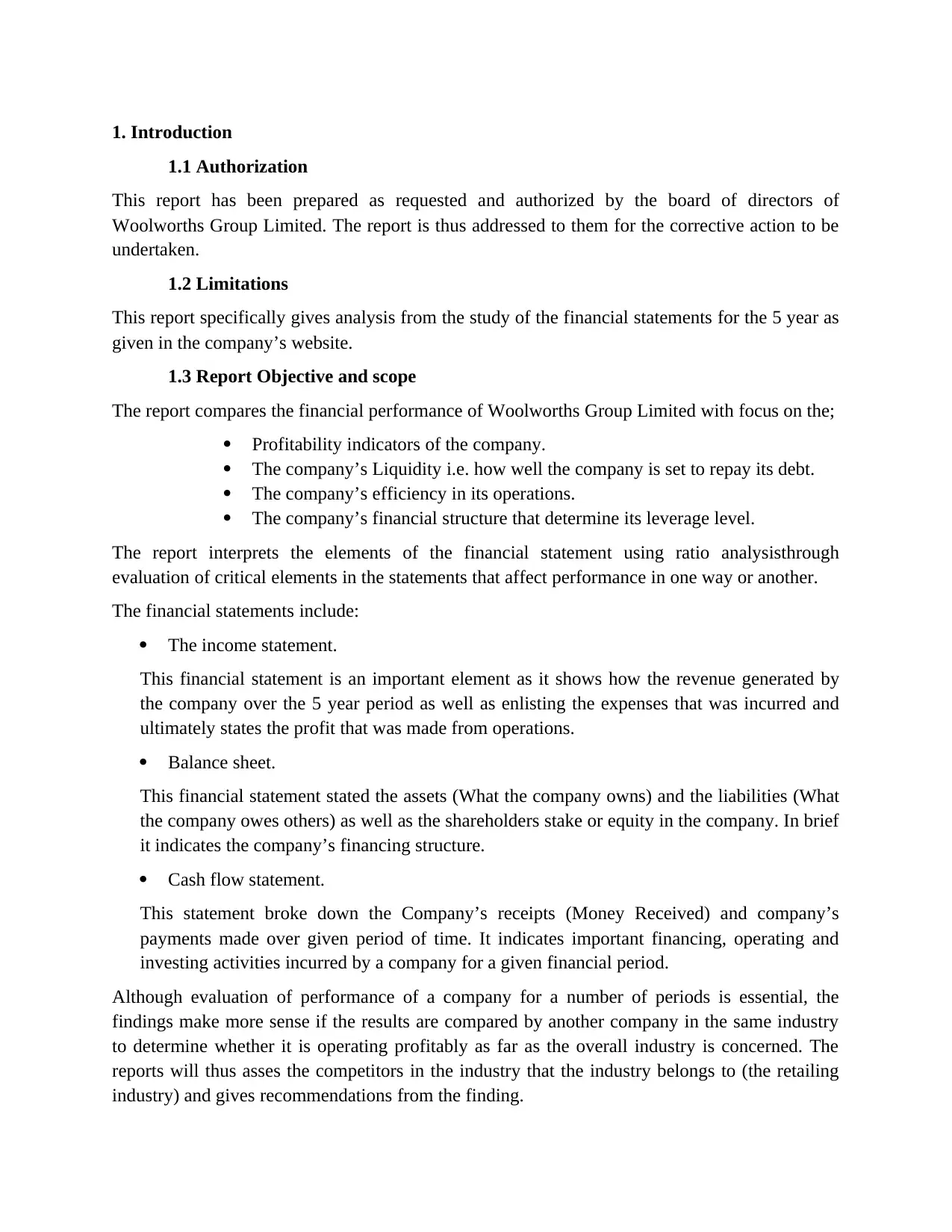
1. Introduction
1.1 Authorization
This report has been prepared as requested and authorized by the board of directors of
Woolworths Group Limited. The report is thus addressed to them for the corrective action to be
undertaken.
1.2 Limitations
This report specifically gives analysis from the study of the financial statements for the 5 year as
given in the company’s website.
1.3 Report Objective and scope
The report compares the financial performance of Woolworths Group Limited with focus on the;
Profitability indicators of the company.
The company’s Liquidity i.e. how well the company is set to repay its debt.
The company’s efficiency in its operations.
The company’s financial structure that determine its leverage level.
The report interprets the elements of the financial statement using ratio analysisthrough
evaluation of critical elements in the statements that affect performance in one way or another.
The financial statements include:
The income statement.
This financial statement is an important element as it shows how the revenue generated by
the company over the 5 year period as well as enlisting the expenses that was incurred and
ultimately states the profit that was made from operations.
Balance sheet.
This financial statement stated the assets (What the company owns) and the liabilities (What
the company owes others) as well as the shareholders stake or equity in the company. In brief
it indicates the company’s financing structure.
Cash flow statement.
This statement broke down the Company’s receipts (Money Received) and company’s
payments made over given period of time. It indicates important financing, operating and
investing activities incurred by a company for a given financial period.
Although evaluation of performance of a company for a number of periods is essential, the
findings make more sense if the results are compared by another company in the same industry
to determine whether it is operating profitably as far as the overall industry is concerned. The
reports will thus asses the competitors in the industry that the industry belongs to (the retailing
industry) and gives recommendations from the finding.
1.1 Authorization
This report has been prepared as requested and authorized by the board of directors of
Woolworths Group Limited. The report is thus addressed to them for the corrective action to be
undertaken.
1.2 Limitations
This report specifically gives analysis from the study of the financial statements for the 5 year as
given in the company’s website.
1.3 Report Objective and scope
The report compares the financial performance of Woolworths Group Limited with focus on the;
Profitability indicators of the company.
The company’s Liquidity i.e. how well the company is set to repay its debt.
The company’s efficiency in its operations.
The company’s financial structure that determine its leverage level.
The report interprets the elements of the financial statement using ratio analysisthrough
evaluation of critical elements in the statements that affect performance in one way or another.
The financial statements include:
The income statement.
This financial statement is an important element as it shows how the revenue generated by
the company over the 5 year period as well as enlisting the expenses that was incurred and
ultimately states the profit that was made from operations.
Balance sheet.
This financial statement stated the assets (What the company owns) and the liabilities (What
the company owes others) as well as the shareholders stake or equity in the company. In brief
it indicates the company’s financing structure.
Cash flow statement.
This statement broke down the Company’s receipts (Money Received) and company’s
payments made over given period of time. It indicates important financing, operating and
investing activities incurred by a company for a given financial period.
Although evaluation of performance of a company for a number of periods is essential, the
findings make more sense if the results are compared by another company in the same industry
to determine whether it is operating profitably as far as the overall industry is concerned. The
reports will thus asses the competitors in the industry that the industry belongs to (the retailing
industry) and gives recommendations from the finding.
Secure Best Marks with AI Grader
Need help grading? Try our AI Grader for instant feedback on your assignments.
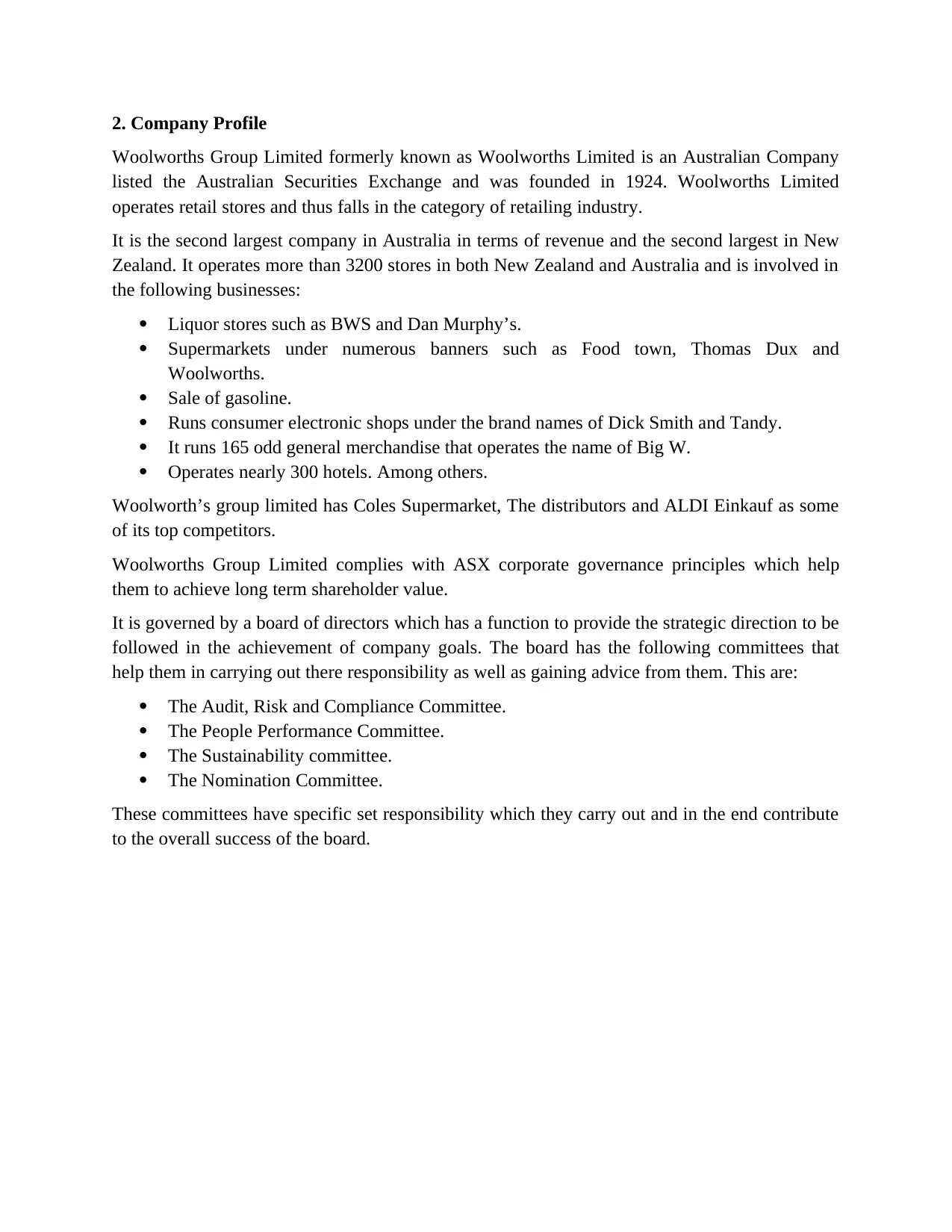
2. Company Profile
Woolworths Group Limited formerly known as Woolworths Limited is an Australian Company
listed the Australian Securities Exchange and was founded in 1924. Woolworths Limited
operates retail stores and thus falls in the category of retailing industry.
It is the second largest company in Australia in terms of revenue and the second largest in New
Zealand. It operates more than 3200 stores in both New Zealand and Australia and is involved in
the following businesses:
Liquor stores such as BWS and Dan Murphy’s.
Supermarkets under numerous banners such as Food town, Thomas Dux and
Woolworths.
Sale of gasoline.
Runs consumer electronic shops under the brand names of Dick Smith and Tandy.
It runs 165 odd general merchandise that operates the name of Big W.
Operates nearly 300 hotels. Among others.
Woolworth’s group limited has Coles Supermarket, The distributors and ALDI Einkauf as some
of its top competitors.
Woolworths Group Limited complies with ASX corporate governance principles which help
them to achieve long term shareholder value.
It is governed by a board of directors which has a function to provide the strategic direction to be
followed in the achievement of company goals. The board has the following committees that
help them in carrying out there responsibility as well as gaining advice from them. This are:
The Audit, Risk and Compliance Committee.
The People Performance Committee.
The Sustainability committee.
The Nomination Committee.
These committees have specific set responsibility which they carry out and in the end contribute
to the overall success of the board.
Woolworths Group Limited formerly known as Woolworths Limited is an Australian Company
listed the Australian Securities Exchange and was founded in 1924. Woolworths Limited
operates retail stores and thus falls in the category of retailing industry.
It is the second largest company in Australia in terms of revenue and the second largest in New
Zealand. It operates more than 3200 stores in both New Zealand and Australia and is involved in
the following businesses:
Liquor stores such as BWS and Dan Murphy’s.
Supermarkets under numerous banners such as Food town, Thomas Dux and
Woolworths.
Sale of gasoline.
Runs consumer electronic shops under the brand names of Dick Smith and Tandy.
It runs 165 odd general merchandise that operates the name of Big W.
Operates nearly 300 hotels. Among others.
Woolworth’s group limited has Coles Supermarket, The distributors and ALDI Einkauf as some
of its top competitors.
Woolworths Group Limited complies with ASX corporate governance principles which help
them to achieve long term shareholder value.
It is governed by a board of directors which has a function to provide the strategic direction to be
followed in the achievement of company goals. The board has the following committees that
help them in carrying out there responsibility as well as gaining advice from them. This are:
The Audit, Risk and Compliance Committee.
The People Performance Committee.
The Sustainability committee.
The Nomination Committee.
These committees have specific set responsibility which they carry out and in the end contribute
to the overall success of the board.
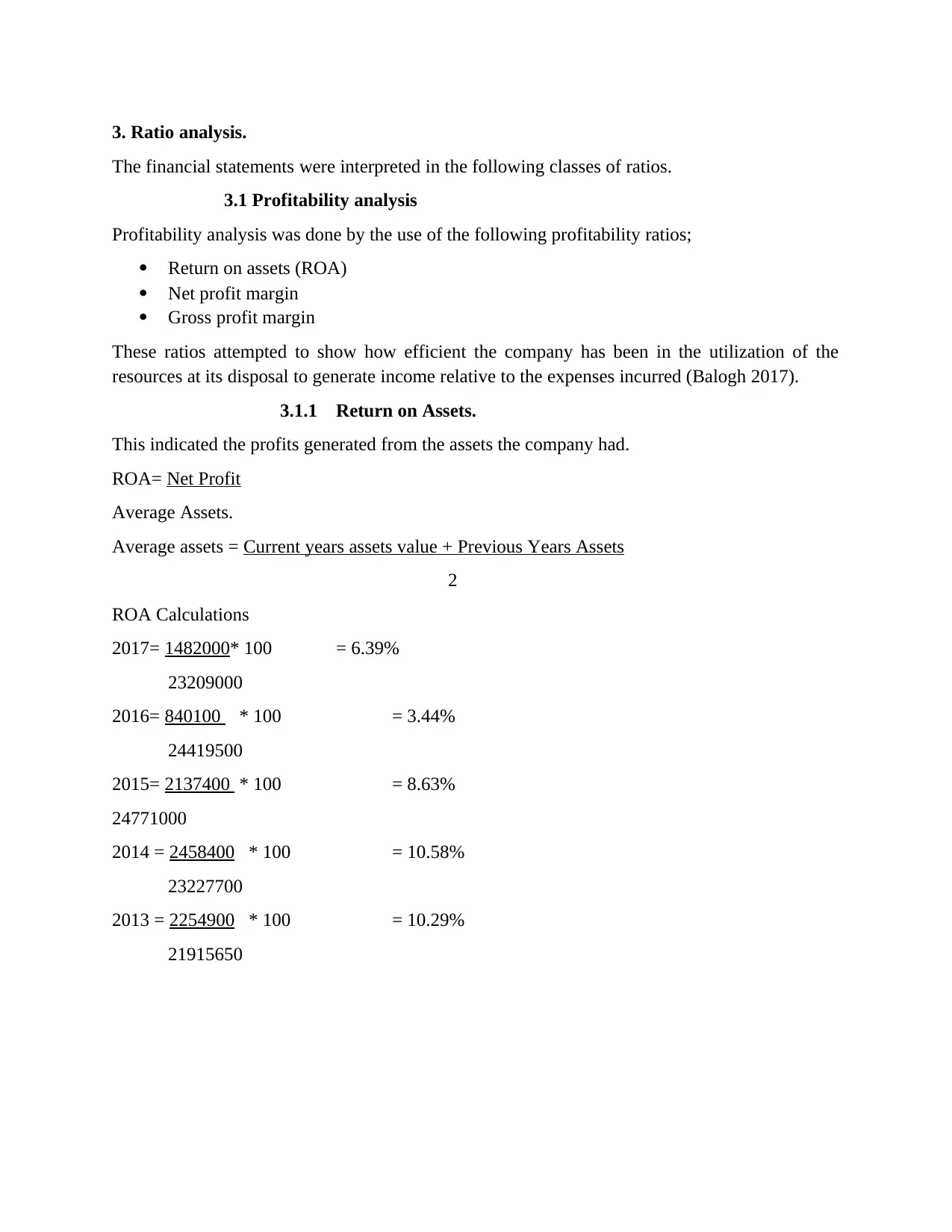
3. Ratio analysis.
The financial statements were interpreted in the following classes of ratios.
3.1 Profitability analysis
Profitability analysis was done by the use of the following profitability ratios;
Return on assets (ROA)
Net profit margin
Gross profit margin
These ratios attempted to show how efficient the company has been in the utilization of the
resources at its disposal to generate income relative to the expenses incurred (Balogh 2017).
3.1.1 Return on Assets.
This indicated the profits generated from the assets the company had.
ROA= Net Profit
Average Assets.
Average assets = Current years assets value + Previous Years Assets
2
ROA Calculations
2017= 1482000* 100 = 6.39%
23209000
2016= 840100 * 100 = 3.44%
24419500
2015= 2137400 * 100 = 8.63%
24771000
2014 = 2458400 * 100 = 10.58%
23227700
2013 = 2254900 * 100 = 10.29%
21915650
The financial statements were interpreted in the following classes of ratios.
3.1 Profitability analysis
Profitability analysis was done by the use of the following profitability ratios;
Return on assets (ROA)
Net profit margin
Gross profit margin
These ratios attempted to show how efficient the company has been in the utilization of the
resources at its disposal to generate income relative to the expenses incurred (Balogh 2017).
3.1.1 Return on Assets.
This indicated the profits generated from the assets the company had.
ROA= Net Profit
Average Assets.
Average assets = Current years assets value + Previous Years Assets
2
ROA Calculations
2017= 1482000* 100 = 6.39%
23209000
2016= 840100 * 100 = 3.44%
24419500
2015= 2137400 * 100 = 8.63%
24771000
2014 = 2458400 * 100 = 10.58%
23227700
2013 = 2254900 * 100 = 10.29%
21915650
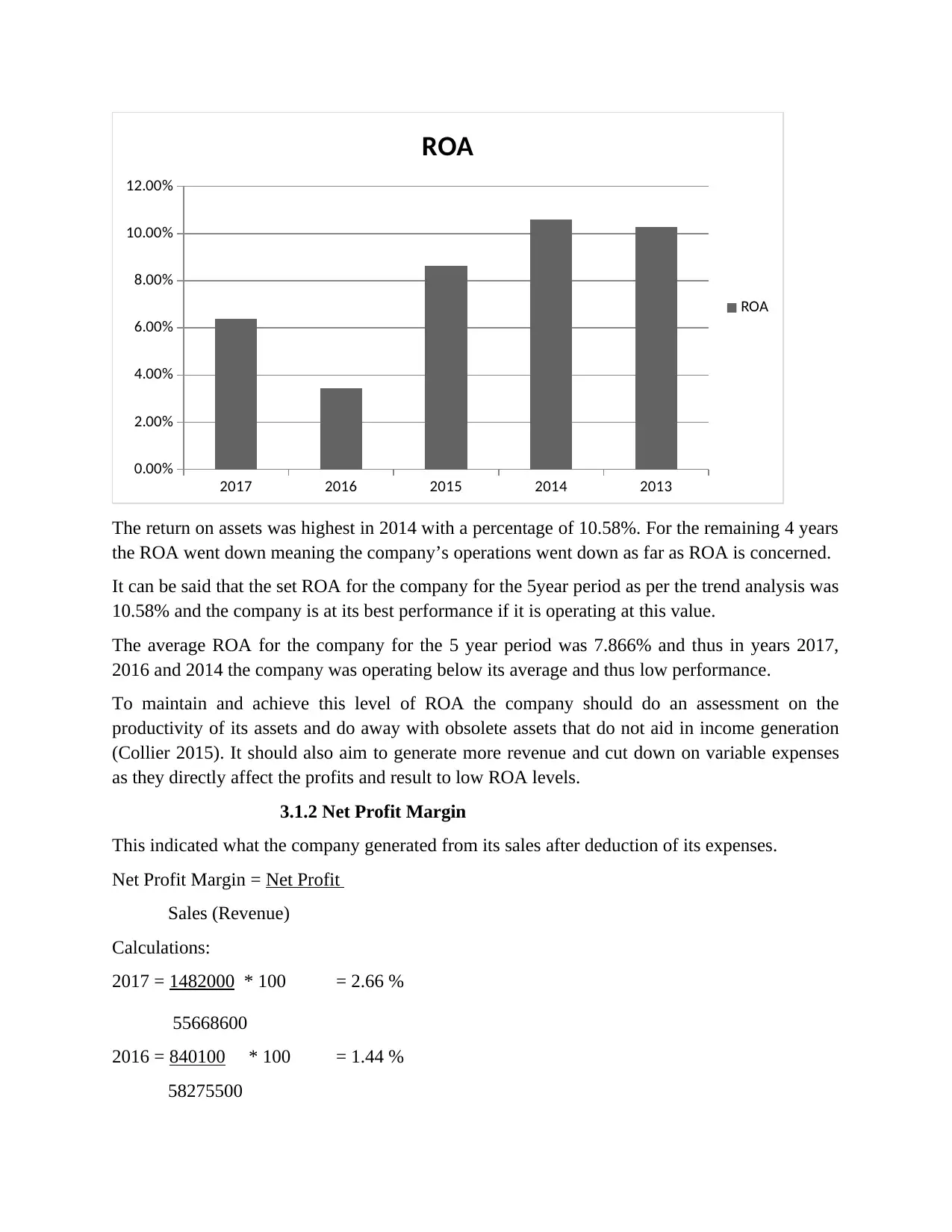
2017 2016 2015 2014 2013
0.00%
2.00%
4.00%
6.00%
8.00%
10.00%
12.00%
ROA
ROA
The return on assets was highest in 2014 with a percentage of 10.58%. For the remaining 4 years
the ROA went down meaning the company’s operations went down as far as ROA is concerned.
It can be said that the set ROA for the company for the 5year period as per the trend analysis was
10.58% and the company is at its best performance if it is operating at this value.
The average ROA for the company for the 5 year period was 7.866% and thus in years 2017,
2016 and 2014 the company was operating below its average and thus low performance.
To maintain and achieve this level of ROA the company should do an assessment on the
productivity of its assets and do away with obsolete assets that do not aid in income generation
(Collier 2015). It should also aim to generate more revenue and cut down on variable expenses
as they directly affect the profits and result to low ROA levels.
3.1.2 Net Profit Margin
This indicated what the company generated from its sales after deduction of its expenses.
Net Profit Margin = Net Profit
Sales (Revenue)
Calculations:
2017 = 1482000 * 100 = 2.66 %
55668600
2016 = 840100 * 100 = 1.44 %
58275500
0.00%
2.00%
4.00%
6.00%
8.00%
10.00%
12.00%
ROA
ROA
The return on assets was highest in 2014 with a percentage of 10.58%. For the remaining 4 years
the ROA went down meaning the company’s operations went down as far as ROA is concerned.
It can be said that the set ROA for the company for the 5year period as per the trend analysis was
10.58% and the company is at its best performance if it is operating at this value.
The average ROA for the company for the 5 year period was 7.866% and thus in years 2017,
2016 and 2014 the company was operating below its average and thus low performance.
To maintain and achieve this level of ROA the company should do an assessment on the
productivity of its assets and do away with obsolete assets that do not aid in income generation
(Collier 2015). It should also aim to generate more revenue and cut down on variable expenses
as they directly affect the profits and result to low ROA levels.
3.1.2 Net Profit Margin
This indicated what the company generated from its sales after deduction of its expenses.
Net Profit Margin = Net Profit
Sales (Revenue)
Calculations:
2017 = 1482000 * 100 = 2.66 %
55668600
2016 = 840100 * 100 = 1.44 %
58275500
Paraphrase This Document
Need a fresh take? Get an instant paraphrase of this document with our AI Paraphraser
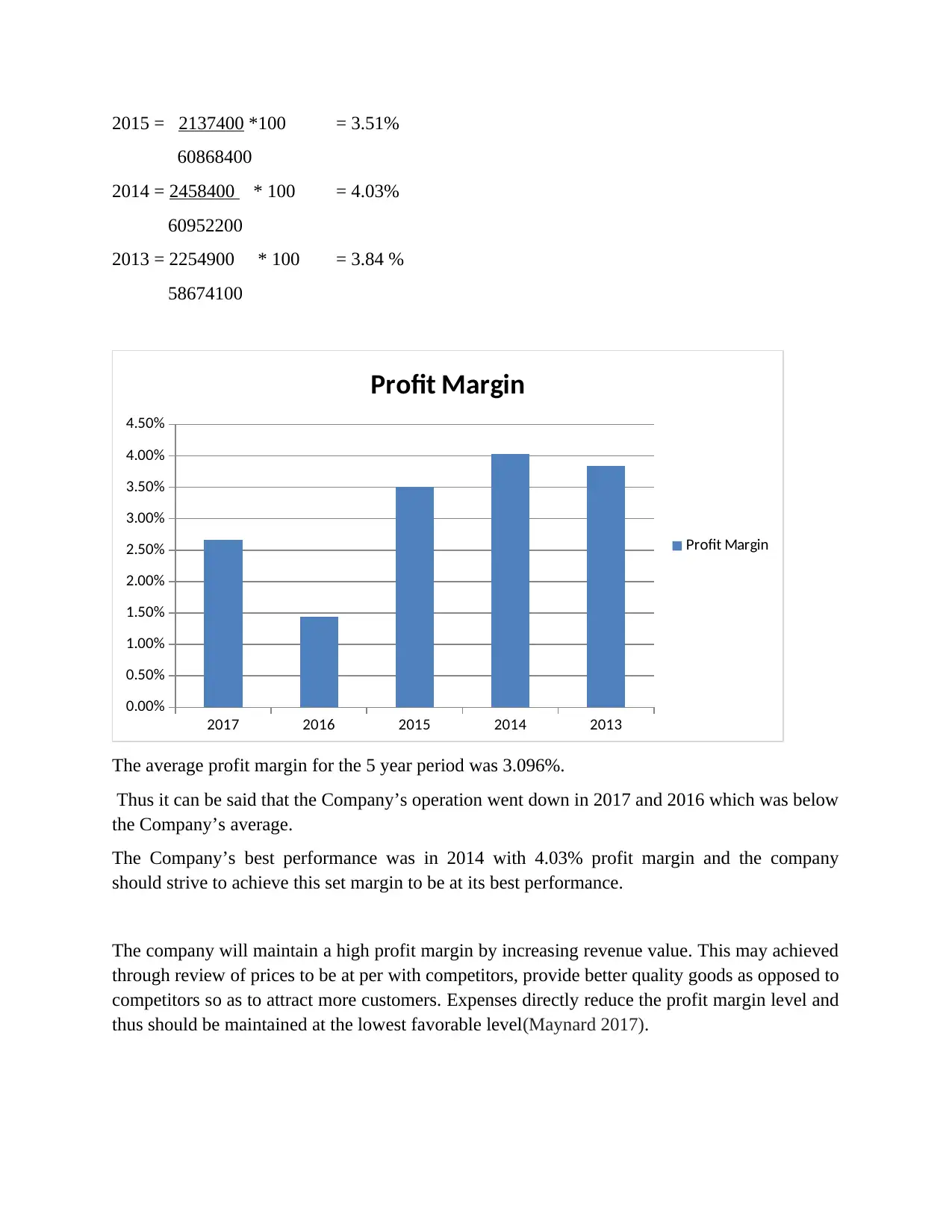
2015 = 2137400 *100 = 3.51%
60868400
2014 = 2458400 * 100 = 4.03%
60952200
2013 = 2254900 * 100 = 3.84 %
58674100
2017 2016 2015 2014 2013
0.00%
0.50%
1.00%
1.50%
2.00%
2.50%
3.00%
3.50%
4.00%
4.50%
Profit Margin
Profit Margin
The average profit margin for the 5 year period was 3.096%.
Thus it can be said that the Company’s operation went down in 2017 and 2016 which was below
the Company’s average.
The Company’s best performance was in 2014 with 4.03% profit margin and the company
should strive to achieve this set margin to be at its best performance.
The company will maintain a high profit margin by increasing revenue value. This may achieved
through review of prices to be at per with competitors, provide better quality goods as opposed to
competitors so as to attract more customers. Expenses directly reduce the profit margin level and
thus should be maintained at the lowest favorable level(Maynard 2017).
60868400
2014 = 2458400 * 100 = 4.03%
60952200
2013 = 2254900 * 100 = 3.84 %
58674100
2017 2016 2015 2014 2013
0.00%
0.50%
1.00%
1.50%
2.00%
2.50%
3.00%
3.50%
4.00%
4.50%
Profit Margin
Profit Margin
The average profit margin for the 5 year period was 3.096%.
Thus it can be said that the Company’s operation went down in 2017 and 2016 which was below
the Company’s average.
The Company’s best performance was in 2014 with 4.03% profit margin and the company
should strive to achieve this set margin to be at its best performance.
The company will maintain a high profit margin by increasing revenue value. This may achieved
through review of prices to be at per with competitors, provide better quality goods as opposed to
competitors so as to attract more customers. Expenses directly reduce the profit margin level and
thus should be maintained at the lowest favorable level(Maynard 2017).
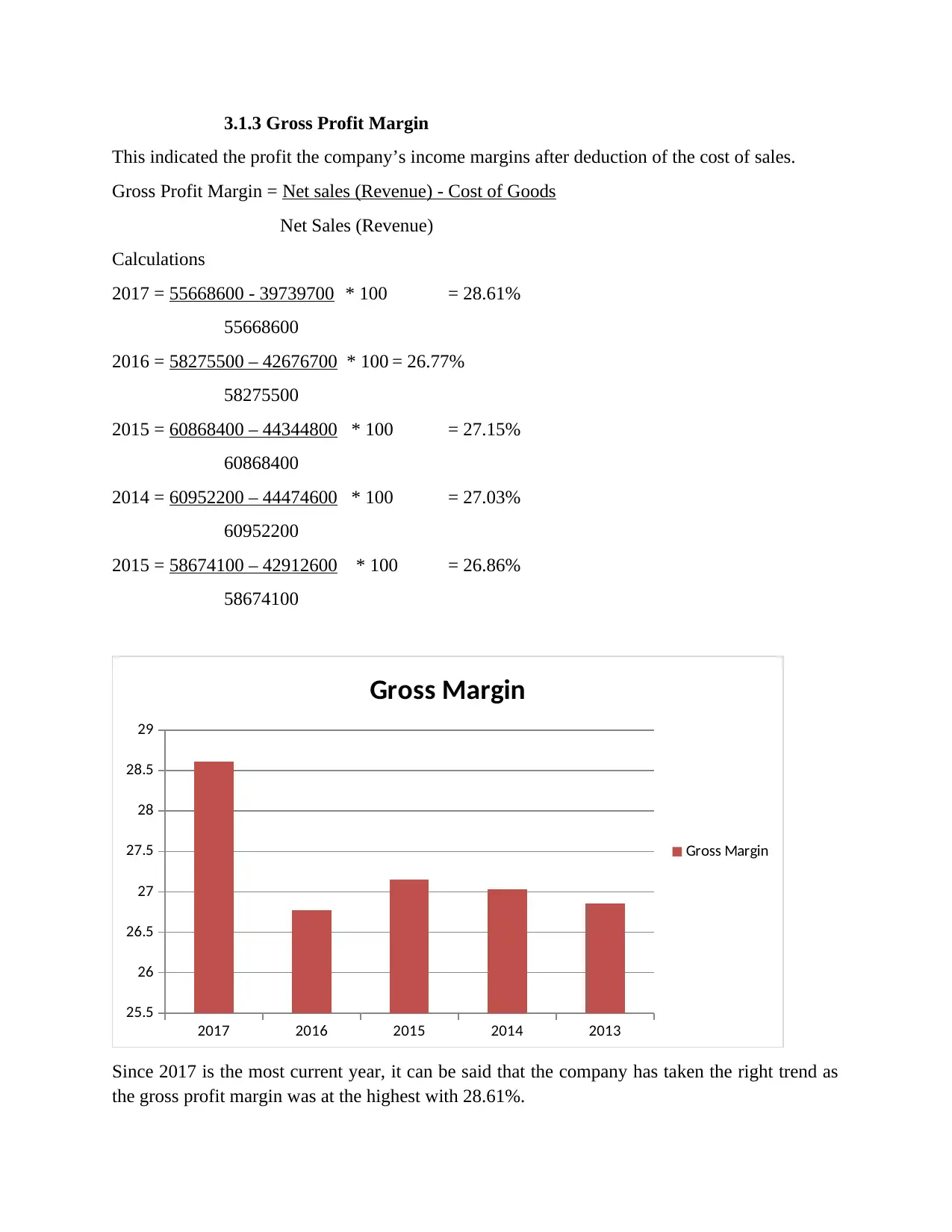
3.1.3 Gross Profit Margin
This indicated the profit the company’s income margins after deduction of the cost of sales.
Gross Profit Margin = Net sales (Revenue) - Cost of Goods
Net Sales (Revenue)
Calculations
2017 = 55668600 - 39739700 * 100 = 28.61%
55668600
2016 = 58275500 – 42676700 * 100 = 26.77%
58275500
2015 = 60868400 – 44344800 * 100 = 27.15%
60868400
2014 = 60952200 – 44474600 * 100 = 27.03%
60952200
2015 = 58674100 – 42912600 * 100 = 26.86%
58674100
2017 2016 2015 2014 2013
25.5
26
26.5
27
27.5
28
28.5
29
Gross Margin
Gross Margin
Since 2017 is the most current year, it can be said that the company has taken the right trend as
the gross profit margin was at the highest with 28.61%.
This indicated the profit the company’s income margins after deduction of the cost of sales.
Gross Profit Margin = Net sales (Revenue) - Cost of Goods
Net Sales (Revenue)
Calculations
2017 = 55668600 - 39739700 * 100 = 28.61%
55668600
2016 = 58275500 – 42676700 * 100 = 26.77%
58275500
2015 = 60868400 – 44344800 * 100 = 27.15%
60868400
2014 = 60952200 – 44474600 * 100 = 27.03%
60952200
2015 = 58674100 – 42912600 * 100 = 26.86%
58674100
2017 2016 2015 2014 2013
25.5
26
26.5
27
27.5
28
28.5
29
Gross Margin
Gross Margin
Since 2017 is the most current year, it can be said that the company has taken the right trend as
the gross profit margin was at the highest with 28.61%.
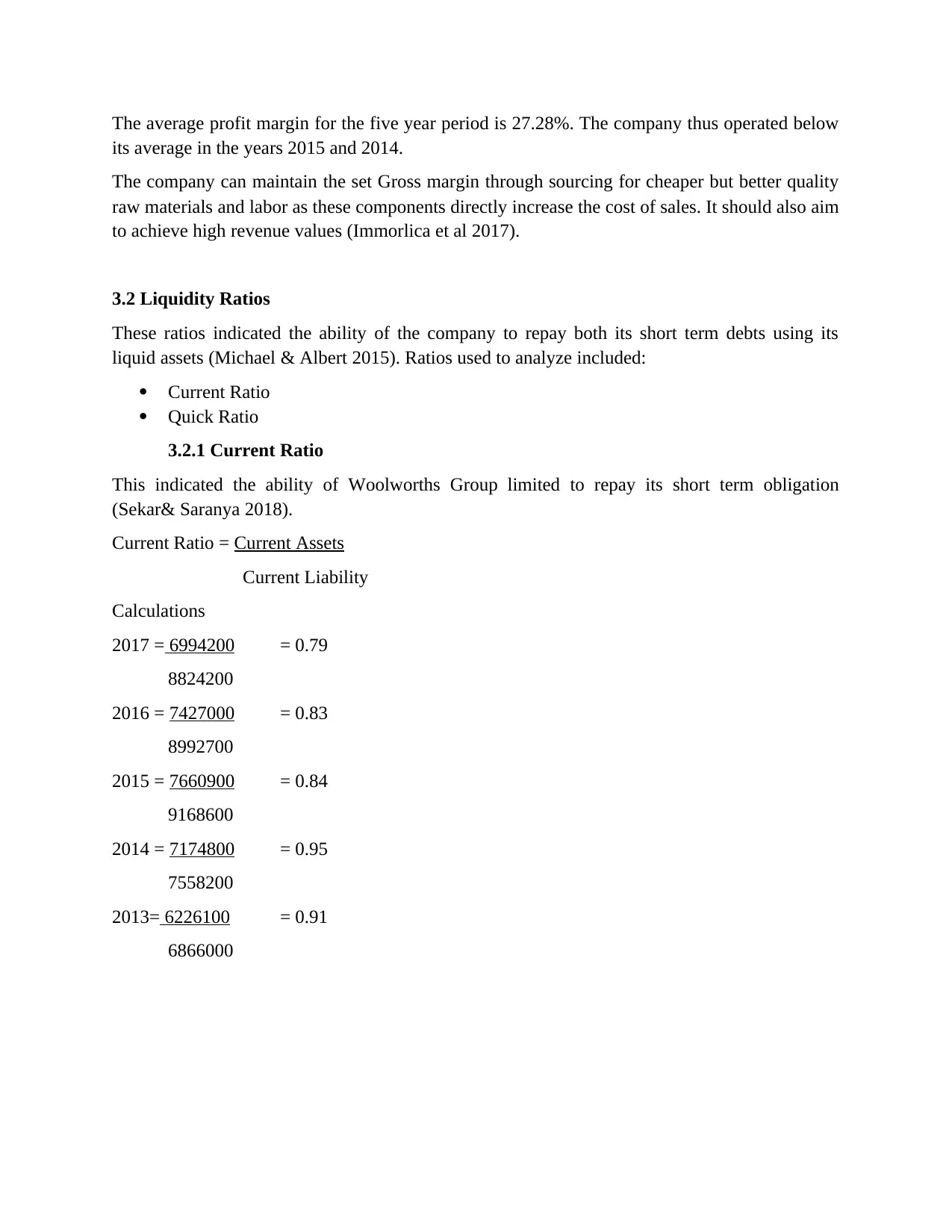
The average profit margin for the five year period is 27.28%. The company thus operated below
its average in the years 2015 and 2014.
The company can maintain the set Gross margin through sourcing for cheaper but better quality
raw materials and labor as these components directly increase the cost of sales. It should also aim
to achieve high revenue values (Immorlica et al 2017).
3.2 Liquidity Ratios
These ratios indicated the ability of the company to repay both its short term debts using its
liquid assets (Michael & Albert 2015). Ratios used to analyze included:
Current Ratio
Quick Ratio
3.2.1 Current Ratio
This indicated the ability of Woolworths Group limited to repay its short term obligation
(Sekar& Saranya 2018).
Current Ratio = Current Assets
Current Liability
Calculations
2017 = 6994200 = 0.79
8824200
2016 = 7427000 = 0.83
8992700
2015 = 7660900 = 0.84
9168600
2014 = 7174800 = 0.95
7558200
2013= 6226100 = 0.91
6866000
its average in the years 2015 and 2014.
The company can maintain the set Gross margin through sourcing for cheaper but better quality
raw materials and labor as these components directly increase the cost of sales. It should also aim
to achieve high revenue values (Immorlica et al 2017).
3.2 Liquidity Ratios
These ratios indicated the ability of the company to repay both its short term debts using its
liquid assets (Michael & Albert 2015). Ratios used to analyze included:
Current Ratio
Quick Ratio
3.2.1 Current Ratio
This indicated the ability of Woolworths Group limited to repay its short term obligation
(Sekar& Saranya 2018).
Current Ratio = Current Assets
Current Liability
Calculations
2017 = 6994200 = 0.79
8824200
2016 = 7427000 = 0.83
8992700
2015 = 7660900 = 0.84
9168600
2014 = 7174800 = 0.95
7558200
2013= 6226100 = 0.91
6866000
Secure Best Marks with AI Grader
Need help grading? Try our AI Grader for instant feedback on your assignments.
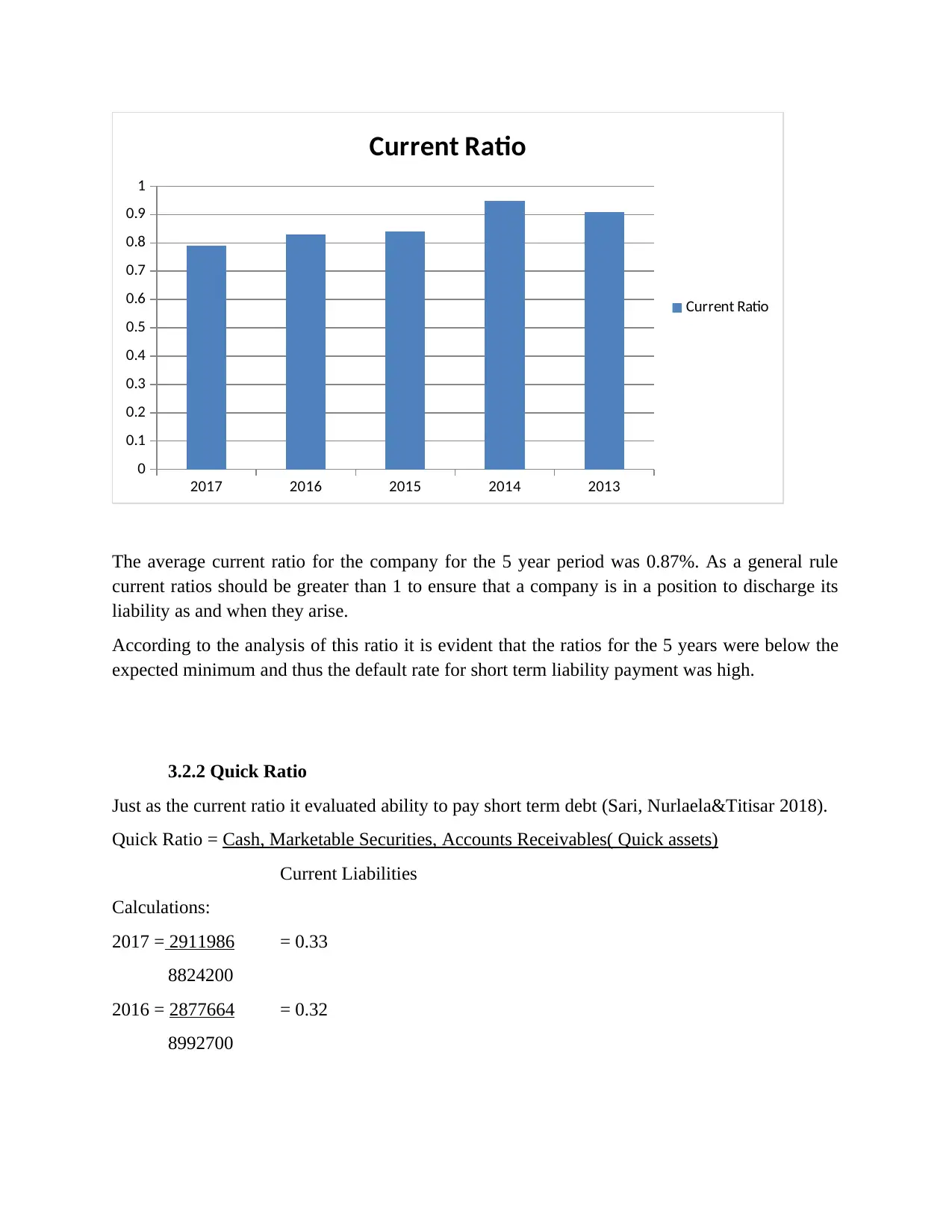
2017 2016 2015 2014 2013
0
0.1
0.2
0.3
0.4
0.5
0.6
0.7
0.8
0.9
1
Current Ratio
Current Ratio
The average current ratio for the company for the 5 year period was 0.87%. As a general rule
current ratios should be greater than 1 to ensure that a company is in a position to discharge its
liability as and when they arise.
According to the analysis of this ratio it is evident that the ratios for the 5 years were below the
expected minimum and thus the default rate for short term liability payment was high.
3.2.2 Quick Ratio
Just as the current ratio it evaluated ability to pay short term debt (Sari, Nurlaela&Titisar 2018).
Quick Ratio = Cash, Marketable Securities, Accounts Receivables( Quick assets)
Current Liabilities
Calculations:
2017 = 2911986 = 0.33
8824200
2016 = 2877664 = 0.32
8992700
0
0.1
0.2
0.3
0.4
0.5
0.6
0.7
0.8
0.9
1
Current Ratio
Current Ratio
The average current ratio for the company for the 5 year period was 0.87%. As a general rule
current ratios should be greater than 1 to ensure that a company is in a position to discharge its
liability as and when they arise.
According to the analysis of this ratio it is evident that the ratios for the 5 years were below the
expected minimum and thus the default rate for short term liability payment was high.
3.2.2 Quick Ratio
Just as the current ratio it evaluated ability to pay short term debt (Sari, Nurlaela&Titisar 2018).
Quick Ratio = Cash, Marketable Securities, Accounts Receivables( Quick assets)
Current Liabilities
Calculations:
2017 = 2911986 = 0.33
8824200
2016 = 2877664 = 0.32
8992700
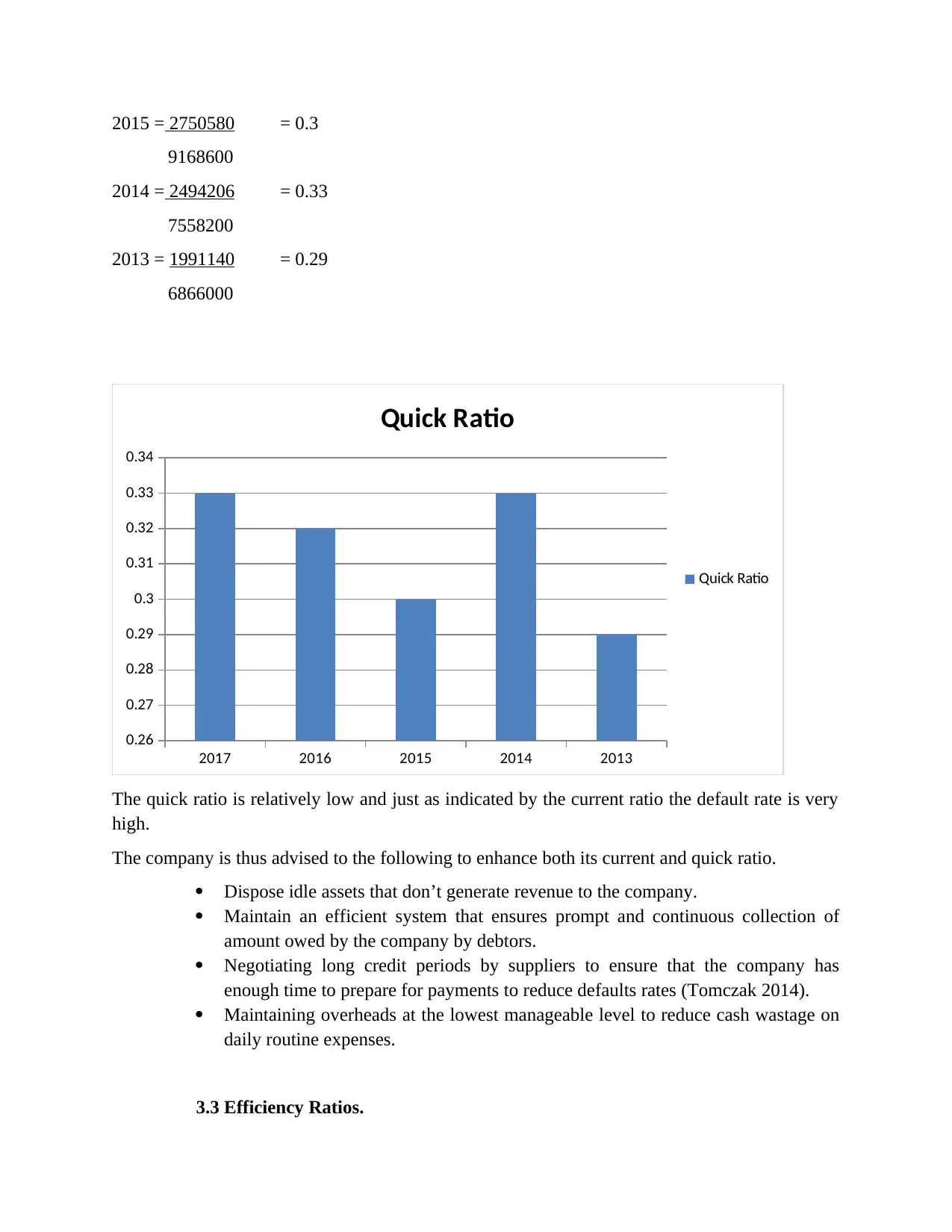
2015 = 2750580 = 0.3
9168600
2014 = 2494206 = 0.33
7558200
2013 = 1991140 = 0.29
6866000
2017 2016 2015 2014 2013
0.26
0.27
0.28
0.29
0.3
0.31
0.32
0.33
0.34
Quick Ratio
Quick Ratio
The quick ratio is relatively low and just as indicated by the current ratio the default rate is very
high.
The company is thus advised to the following to enhance both its current and quick ratio.
Dispose idle assets that don’t generate revenue to the company.
Maintain an efficient system that ensures prompt and continuous collection of
amount owed by the company by debtors.
Negotiating long credit periods by suppliers to ensure that the company has
enough time to prepare for payments to reduce defaults rates (Tomczak 2014).
Maintaining overheads at the lowest manageable level to reduce cash wastage on
daily routine expenses.
3.3 Efficiency Ratios.
9168600
2014 = 2494206 = 0.33
7558200
2013 = 1991140 = 0.29
6866000
2017 2016 2015 2014 2013
0.26
0.27
0.28
0.29
0.3
0.31
0.32
0.33
0.34
Quick Ratio
Quick Ratio
The quick ratio is relatively low and just as indicated by the current ratio the default rate is very
high.
The company is thus advised to the following to enhance both its current and quick ratio.
Dispose idle assets that don’t generate revenue to the company.
Maintain an efficient system that ensures prompt and continuous collection of
amount owed by the company by debtors.
Negotiating long credit periods by suppliers to ensure that the company has
enough time to prepare for payments to reduce defaults rates (Tomczak 2014).
Maintaining overheads at the lowest manageable level to reduce cash wastage on
daily routine expenses.
3.3 Efficiency Ratios.
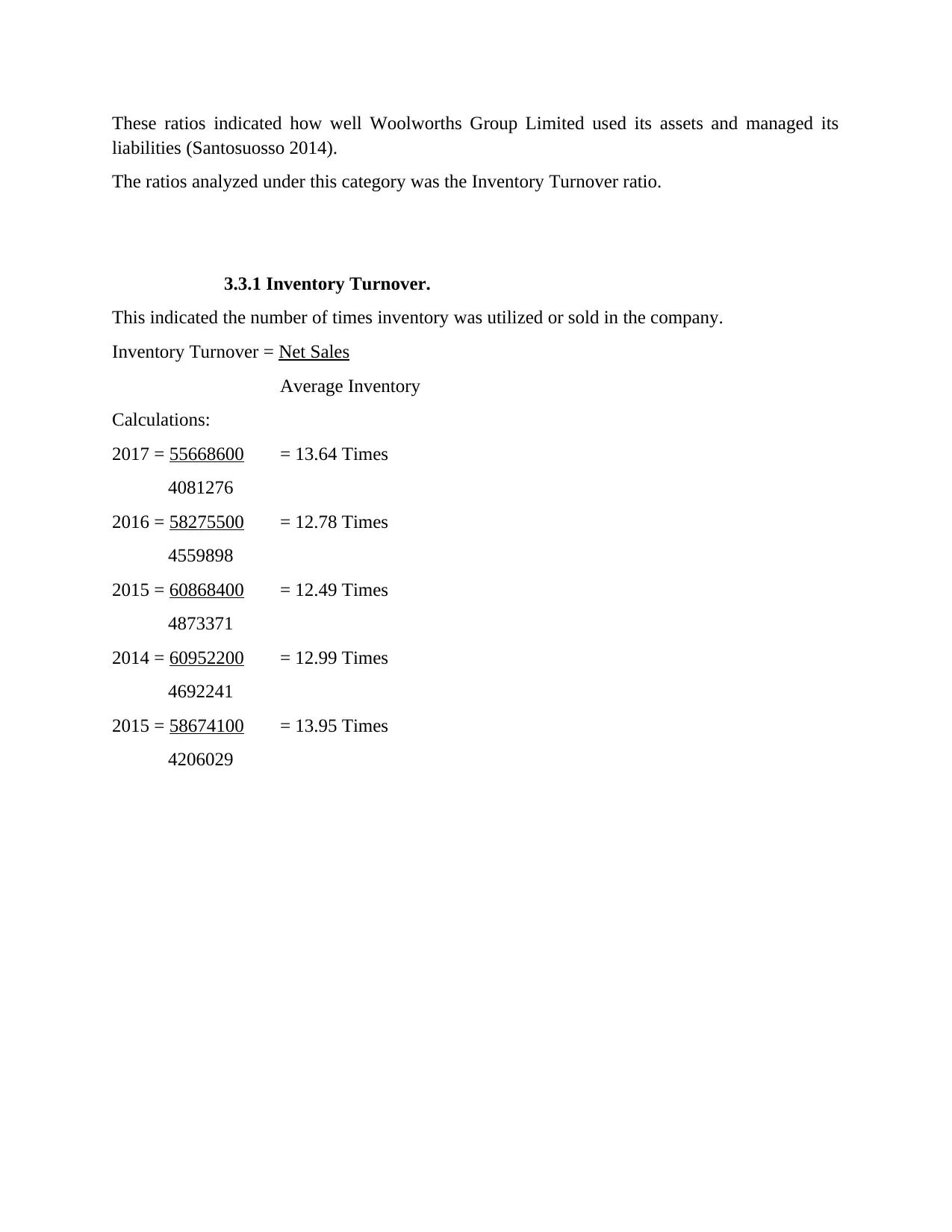
These ratios indicated how well Woolworths Group Limited used its assets and managed its
liabilities (Santosuosso 2014).
The ratios analyzed under this category was the Inventory Turnover ratio.
3.3.1 Inventory Turnover.
This indicated the number of times inventory was utilized or sold in the company.
Inventory Turnover = Net Sales
Average Inventory
Calculations:
2017 = 55668600 = 13.64 Times
4081276
2016 = 58275500 = 12.78 Times
4559898
2015 = 60868400 = 12.49 Times
4873371
2014 = 60952200 = 12.99 Times
4692241
2015 = 58674100 = 13.95 Times
4206029
liabilities (Santosuosso 2014).
The ratios analyzed under this category was the Inventory Turnover ratio.
3.3.1 Inventory Turnover.
This indicated the number of times inventory was utilized or sold in the company.
Inventory Turnover = Net Sales
Average Inventory
Calculations:
2017 = 55668600 = 13.64 Times
4081276
2016 = 58275500 = 12.78 Times
4559898
2015 = 60868400 = 12.49 Times
4873371
2014 = 60952200 = 12.99 Times
4692241
2015 = 58674100 = 13.95 Times
4206029
Paraphrase This Document
Need a fresh take? Get an instant paraphrase of this document with our AI Paraphraser
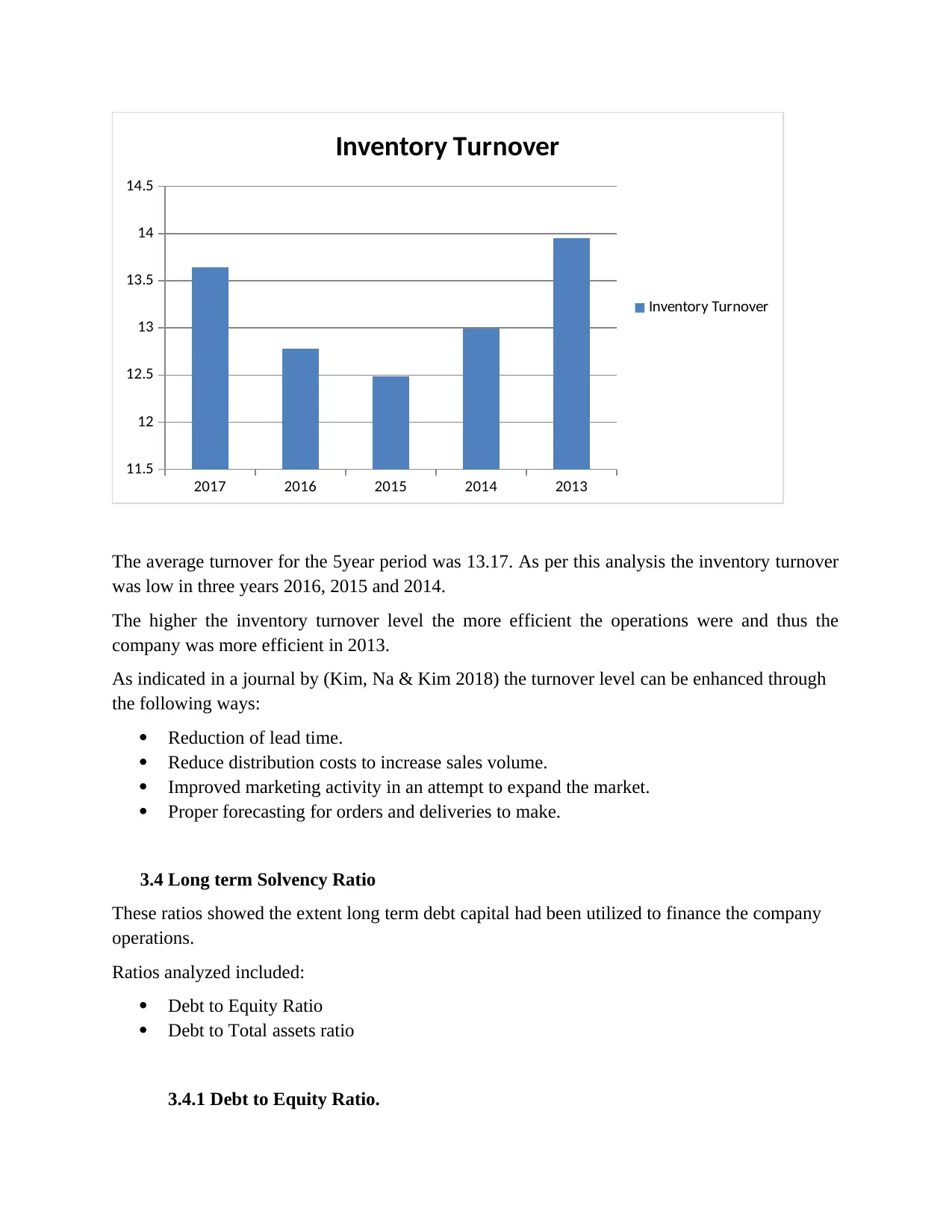
2017 2016 2015 2014 2013
11.5
12
12.5
13
13.5
14
14.5
Inventory Turnover
Inventory Turnover
The average turnover for the 5year period was 13.17. As per this analysis the inventory turnover
was low in three years 2016, 2015 and 2014.
The higher the inventory turnover level the more efficient the operations were and thus the
company was more efficient in 2013.
As indicated in a journal by (Kim, Na & Kim 2018) the turnover level can be enhanced through
the following ways:
Reduction of lead time.
Reduce distribution costs to increase sales volume.
Improved marketing activity in an attempt to expand the market.
Proper forecasting for orders and deliveries to make.
3.4 Long term Solvency Ratio
These ratios showed the extent long term debt capital had been utilized to finance the company
operations.
Ratios analyzed included:
Debt to Equity Ratio
Debt to Total assets ratio
3.4.1 Debt to Equity Ratio.
11.5
12
12.5
13
13.5
14
14.5
Inventory Turnover
Inventory Turnover
The average turnover for the 5year period was 13.17. As per this analysis the inventory turnover
was low in three years 2016, 2015 and 2014.
The higher the inventory turnover level the more efficient the operations were and thus the
company was more efficient in 2013.
As indicated in a journal by (Kim, Na & Kim 2018) the turnover level can be enhanced through
the following ways:
Reduction of lead time.
Reduce distribution costs to increase sales volume.
Improved marketing activity in an attempt to expand the market.
Proper forecasting for orders and deliveries to make.
3.4 Long term Solvency Ratio
These ratios showed the extent long term debt capital had been utilized to finance the company
operations.
Ratios analyzed included:
Debt to Equity Ratio
Debt to Total assets ratio
3.4.1 Debt to Equity Ratio.
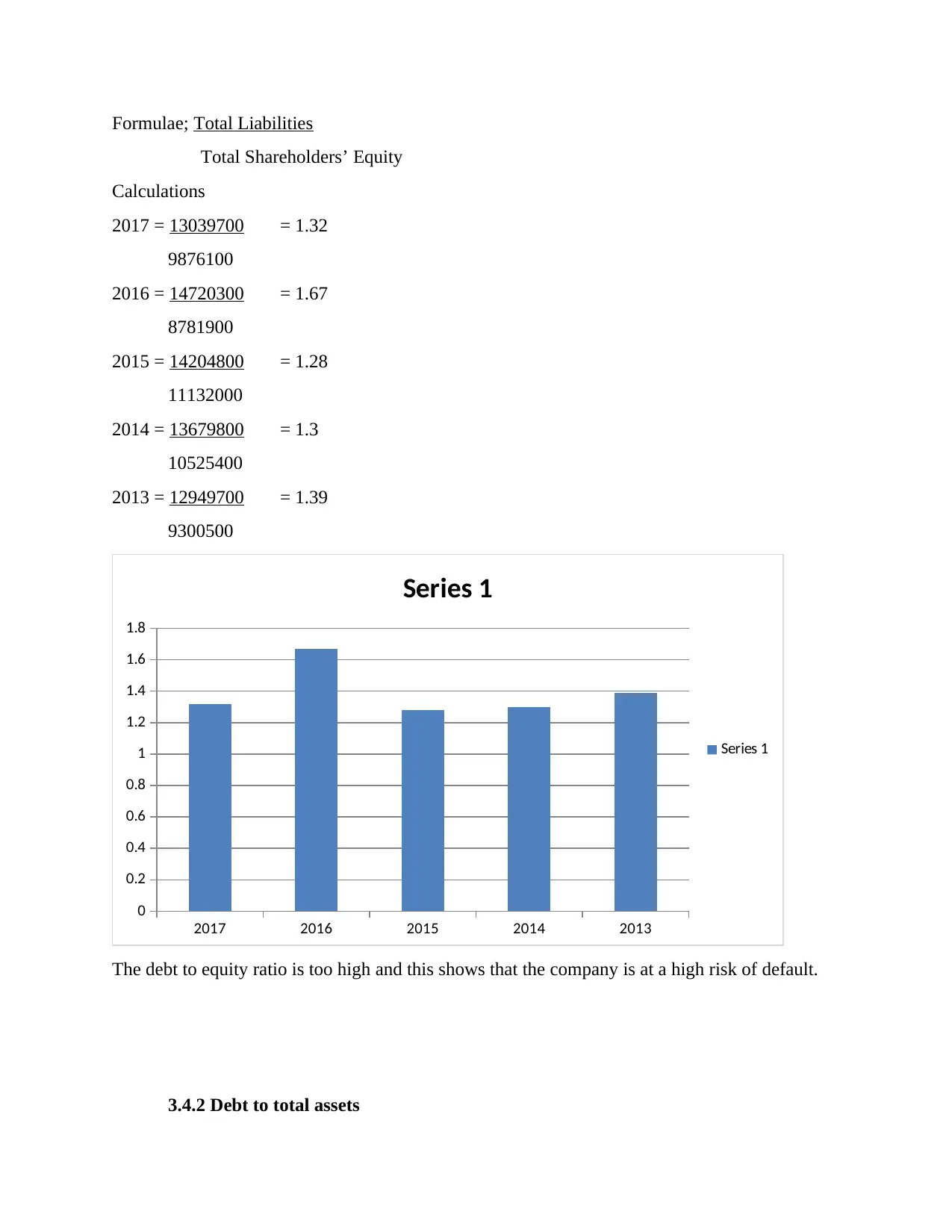
Formulae; Total Liabilities
Total Shareholders’ Equity
Calculations
2017 = 13039700 = 1.32
9876100
2016 = 14720300 = 1.67
8781900
2015 = 14204800 = 1.28
11132000
2014 = 13679800 = 1.3
10525400
2013 = 12949700 = 1.39
9300500
2017 2016 2015 2014 2013
0
0.2
0.4
0.6
0.8
1
1.2
1.4
1.6
1.8
Series 1
Series 1
The debt to equity ratio is too high and this shows that the company is at a high risk of default.
3.4.2 Debt to total assets
Total Shareholders’ Equity
Calculations
2017 = 13039700 = 1.32
9876100
2016 = 14720300 = 1.67
8781900
2015 = 14204800 = 1.28
11132000
2014 = 13679800 = 1.3
10525400
2013 = 12949700 = 1.39
9300500
2017 2016 2015 2014 2013
0
0.2
0.4
0.6
0.8
1
1.2
1.4
1.6
1.8
Series 1
Series 1
The debt to equity ratio is too high and this shows that the company is at a high risk of default.
3.4.2 Debt to total assets
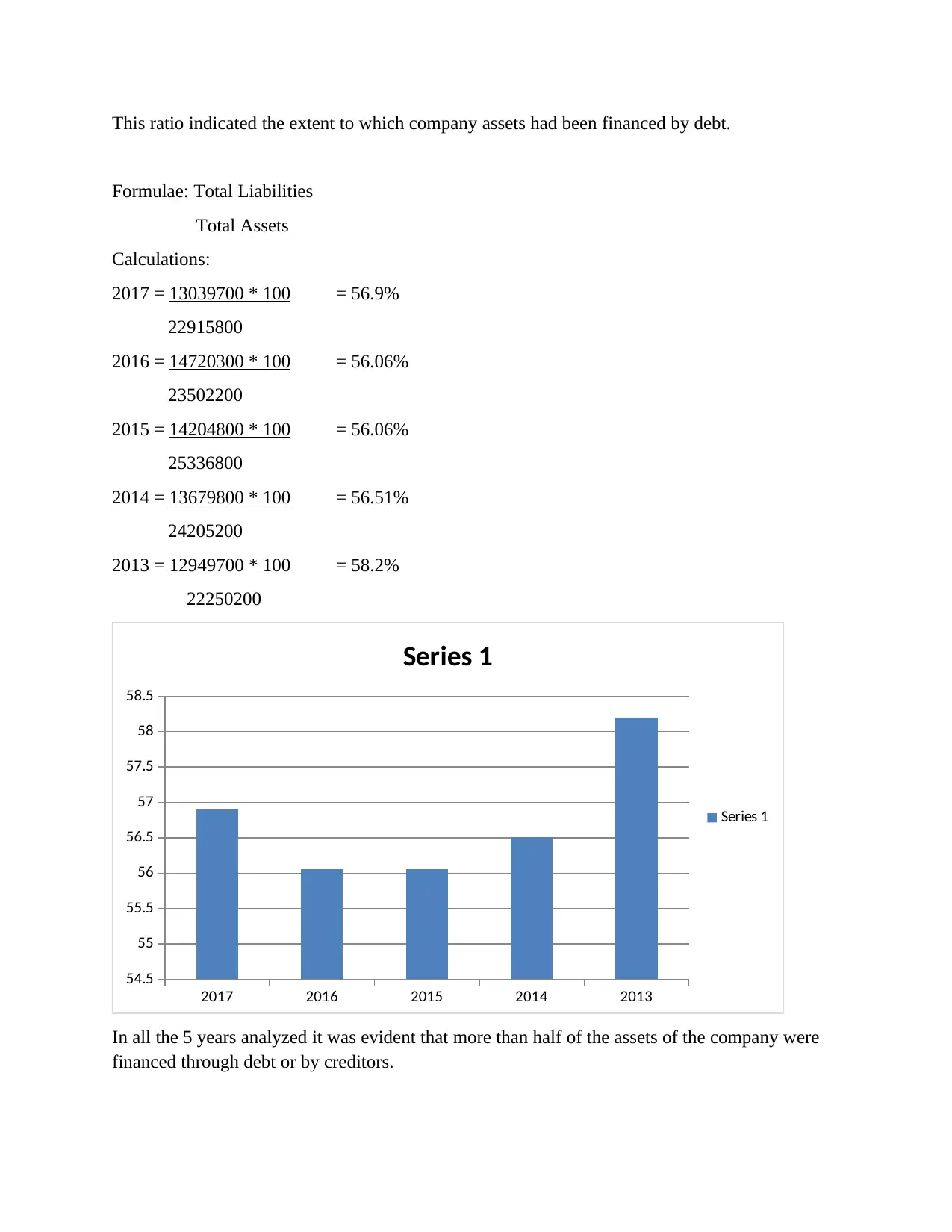
This ratio indicated the extent to which company assets had been financed by debt.
Formulae: Total Liabilities
Total Assets
Calculations:
2017 = 13039700 * 100 = 56.9%
22915800
2016 = 14720300 * 100 = 56.06%
23502200
2015 = 14204800 * 100 = 56.06%
25336800
2014 = 13679800 * 100 = 56.51%
24205200
2013 = 12949700 * 100 = 58.2%
22250200
2017 2016 2015 2014 2013
54.5
55
55.5
56
56.5
57
57.5
58
58.5
Series 1
Series 1
In all the 5 years analyzed it was evident that more than half of the assets of the company were
financed through debt or by creditors.
Formulae: Total Liabilities
Total Assets
Calculations:
2017 = 13039700 * 100 = 56.9%
22915800
2016 = 14720300 * 100 = 56.06%
23502200
2015 = 14204800 * 100 = 56.06%
25336800
2014 = 13679800 * 100 = 56.51%
24205200
2013 = 12949700 * 100 = 58.2%
22250200
2017 2016 2015 2014 2013
54.5
55
55.5
56
56.5
57
57.5
58
58.5
Series 1
Series 1
In all the 5 years analyzed it was evident that more than half of the assets of the company were
financed through debt or by creditors.
Secure Best Marks with AI Grader
Need help grading? Try our AI Grader for instant feedback on your assignments.
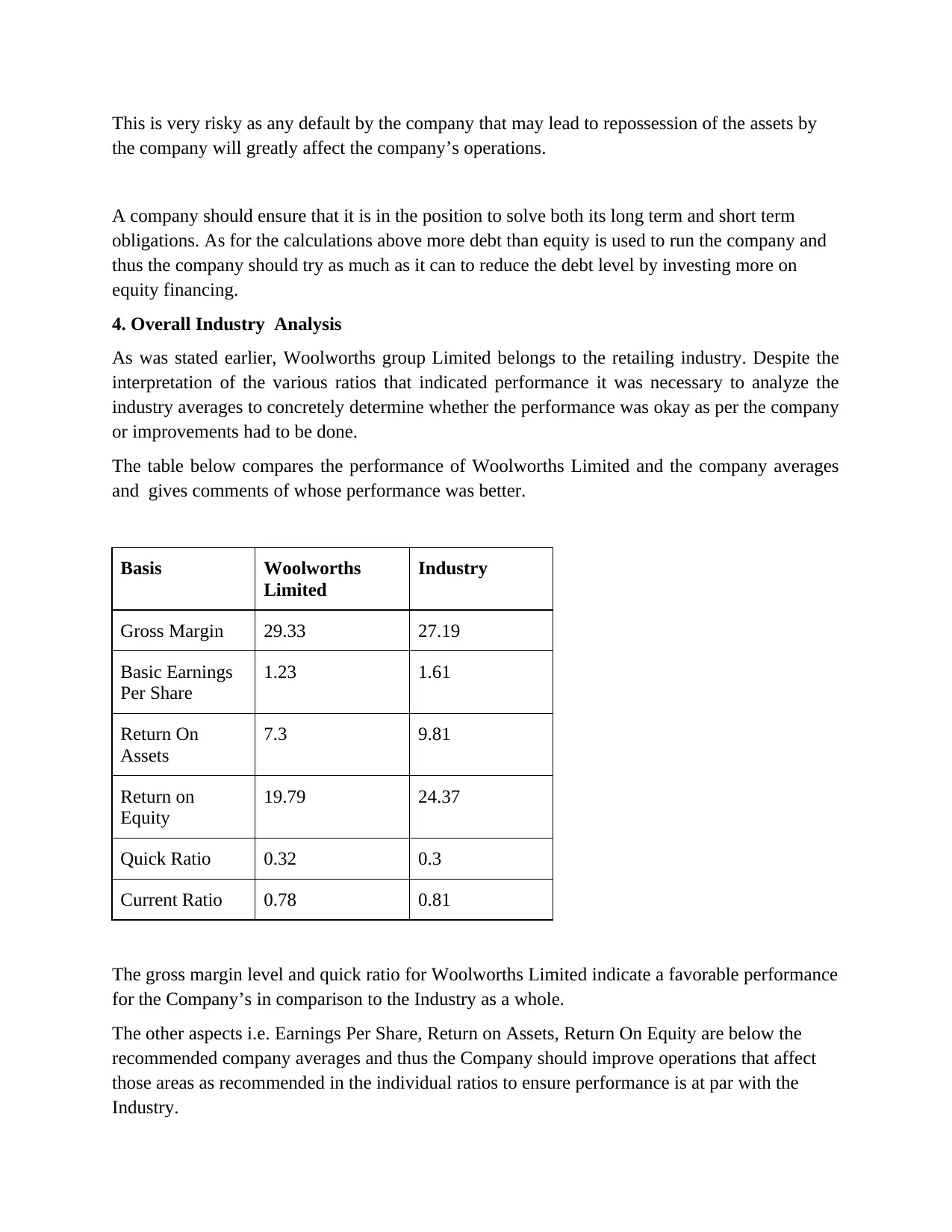
This is very risky as any default by the company that may lead to repossession of the assets by
the company will greatly affect the company’s operations.
A company should ensure that it is in the position to solve both its long term and short term
obligations. As for the calculations above more debt than equity is used to run the company and
thus the company should try as much as it can to reduce the debt level by investing more on
equity financing.
4. Overall Industry Analysis
As was stated earlier, Woolworths group Limited belongs to the retailing industry. Despite the
interpretation of the various ratios that indicated performance it was necessary to analyze the
industry averages to concretely determine whether the performance was okay as per the company
or improvements had to be done.
The table below compares the performance of Woolworths Limited and the company averages
and gives comments of whose performance was better.
Basis Woolworths
Limited
Industry
Gross Margin 29.33 27.19
Basic Earnings
Per Share
1.23 1.61
Return On
Assets
7.3 9.81
Return on
Equity
19.79 24.37
Quick Ratio 0.32 0.3
Current Ratio 0.78 0.81
The gross margin level and quick ratio for Woolworths Limited indicate a favorable performance
for the Company’s in comparison to the Industry as a whole.
The other aspects i.e. Earnings Per Share, Return on Assets, Return On Equity are below the
recommended company averages and thus the Company should improve operations that affect
those areas as recommended in the individual ratios to ensure performance is at par with the
Industry.
the company will greatly affect the company’s operations.
A company should ensure that it is in the position to solve both its long term and short term
obligations. As for the calculations above more debt than equity is used to run the company and
thus the company should try as much as it can to reduce the debt level by investing more on
equity financing.
4. Overall Industry Analysis
As was stated earlier, Woolworths group Limited belongs to the retailing industry. Despite the
interpretation of the various ratios that indicated performance it was necessary to analyze the
industry averages to concretely determine whether the performance was okay as per the company
or improvements had to be done.
The table below compares the performance of Woolworths Limited and the company averages
and gives comments of whose performance was better.
Basis Woolworths
Limited
Industry
Gross Margin 29.33 27.19
Basic Earnings
Per Share
1.23 1.61
Return On
Assets
7.3 9.81
Return on
Equity
19.79 24.37
Quick Ratio 0.32 0.3
Current Ratio 0.78 0.81
The gross margin level and quick ratio for Woolworths Limited indicate a favorable performance
for the Company’s in comparison to the Industry as a whole.
The other aspects i.e. Earnings Per Share, Return on Assets, Return On Equity are below the
recommended company averages and thus the Company should improve operations that affect
those areas as recommended in the individual ratios to ensure performance is at par with the
Industry.
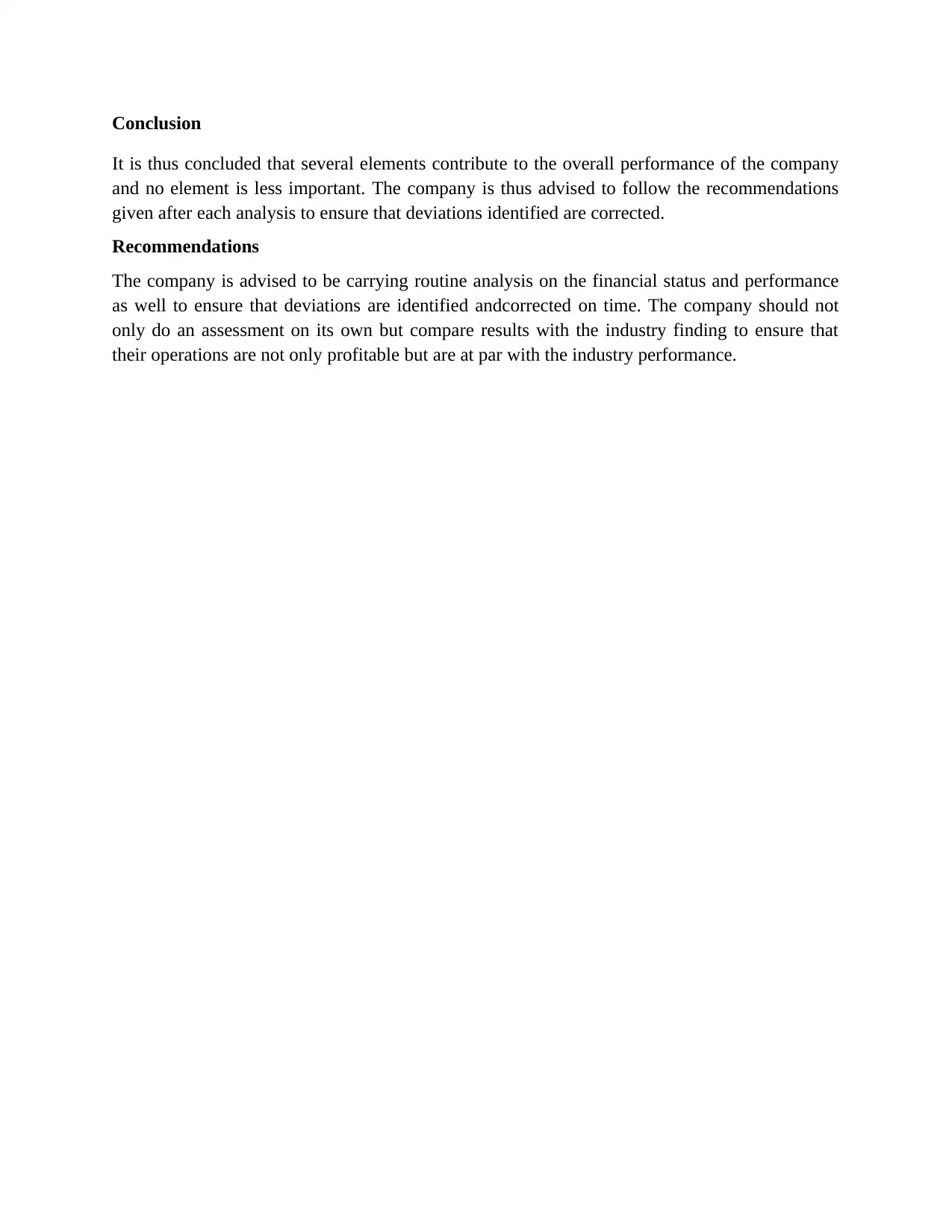
Conclusion
It is thus concluded that several elements contribute to the overall performance of the company
and no element is less important. The company is thus advised to follow the recommendations
given after each analysis to ensure that deviations identified are corrected.
Recommendations
The company is advised to be carrying routine analysis on the financial status and performance
as well to ensure that deviations are identified andcorrected on time. The company should not
only do an assessment on its own but compare results with the industry finding to ensure that
their operations are not only profitable but are at par with the industry performance.
It is thus concluded that several elements contribute to the overall performance of the company
and no element is less important. The company is thus advised to follow the recommendations
given after each analysis to ensure that deviations identified are corrected.
Recommendations
The company is advised to be carrying routine analysis on the financial status and performance
as well to ensure that deviations are identified andcorrected on time. The company should not
only do an assessment on its own but compare results with the industry finding to ensure that
their operations are not only profitable but are at par with the industry performance.
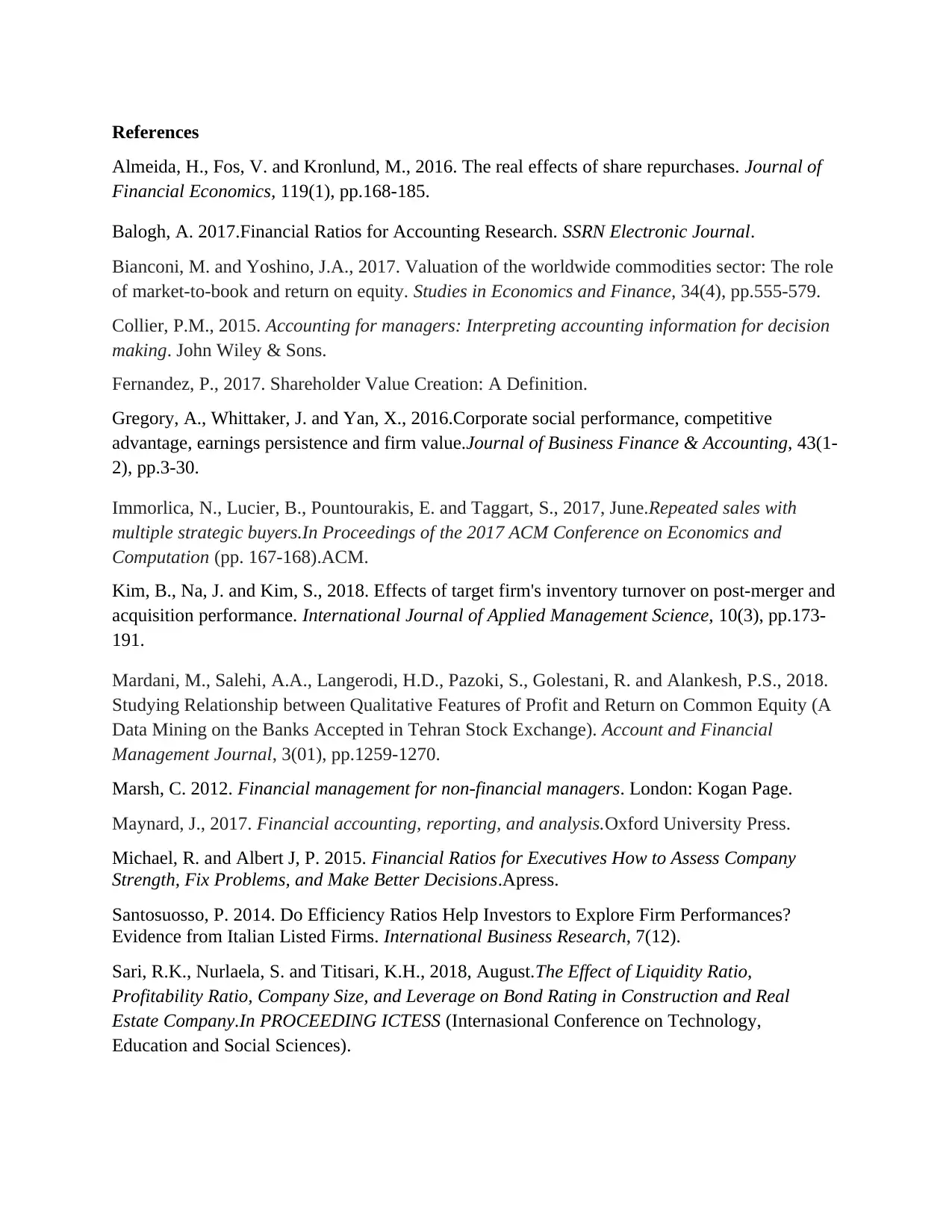
References
Almeida, H., Fos, V. and Kronlund, M., 2016. The real effects of share repurchases. Journal of
Financial Economics, 119(1), pp.168-185.
Balogh, A. 2017.Financial Ratios for Accounting Research. SSRN Electronic Journal.
Bianconi, M. and Yoshino, J.A., 2017. Valuation of the worldwide commodities sector: The role
of market-to-book and return on equity. Studies in Economics and Finance, 34(4), pp.555-579.
Collier, P.M., 2015. Accounting for managers: Interpreting accounting information for decision
making. John Wiley & Sons.
Fernandez, P., 2017. Shareholder Value Creation: A Definition.
Gregory, A., Whittaker, J. and Yan, X., 2016.Corporate social performance, competitive
advantage, earnings persistence and firm value.Journal of Business Finance & Accounting, 43(1-
2), pp.3-30.
Immorlica, N., Lucier, B., Pountourakis, E. and Taggart, S., 2017, June.Repeated sales with
multiple strategic buyers.In Proceedings of the 2017 ACM Conference on Economics and
Computation (pp. 167-168).ACM.
Kim, B., Na, J. and Kim, S., 2018. Effects of target firm's inventory turnover on post-merger and
acquisition performance. International Journal of Applied Management Science, 10(3), pp.173-
191.
Mardani, M., Salehi, A.A., Langerodi, H.D., Pazoki, S., Golestani, R. and Alankesh, P.S., 2018.
Studying Relationship between Qualitative Features of Profit and Return on Common Equity (A
Data Mining on the Banks Accepted in Tehran Stock Exchange). Account and Financial
Management Journal, 3(01), pp.1259-1270.
Marsh, C. 2012. Financial management for non-financial managers. London: Kogan Page.
Maynard, J., 2017. Financial accounting, reporting, and analysis.Oxford University Press.
Michael, R. and Albert J, P. 2015. Financial Ratios for Executives How to Assess Company
Strength, Fix Problems, and Make Better Decisions.Apress.
Santosuosso, P. 2014. Do Efficiency Ratios Help Investors to Explore Firm Performances?
Evidence from Italian Listed Firms. International Business Research, 7(12).
Sari, R.K., Nurlaela, S. and Titisari, K.H., 2018, August.The Effect of Liquidity Ratio,
Profitability Ratio, Company Size, and Leverage on Bond Rating in Construction and Real
Estate Company.In PROCEEDING ICTESS (Internasional Conference on Technology,
Education and Social Sciences).
Almeida, H., Fos, V. and Kronlund, M., 2016. The real effects of share repurchases. Journal of
Financial Economics, 119(1), pp.168-185.
Balogh, A. 2017.Financial Ratios for Accounting Research. SSRN Electronic Journal.
Bianconi, M. and Yoshino, J.A., 2017. Valuation of the worldwide commodities sector: The role
of market-to-book and return on equity. Studies in Economics and Finance, 34(4), pp.555-579.
Collier, P.M., 2015. Accounting for managers: Interpreting accounting information for decision
making. John Wiley & Sons.
Fernandez, P., 2017. Shareholder Value Creation: A Definition.
Gregory, A., Whittaker, J. and Yan, X., 2016.Corporate social performance, competitive
advantage, earnings persistence and firm value.Journal of Business Finance & Accounting, 43(1-
2), pp.3-30.
Immorlica, N., Lucier, B., Pountourakis, E. and Taggart, S., 2017, June.Repeated sales with
multiple strategic buyers.In Proceedings of the 2017 ACM Conference on Economics and
Computation (pp. 167-168).ACM.
Kim, B., Na, J. and Kim, S., 2018. Effects of target firm's inventory turnover on post-merger and
acquisition performance. International Journal of Applied Management Science, 10(3), pp.173-
191.
Mardani, M., Salehi, A.A., Langerodi, H.D., Pazoki, S., Golestani, R. and Alankesh, P.S., 2018.
Studying Relationship between Qualitative Features of Profit and Return on Common Equity (A
Data Mining on the Banks Accepted in Tehran Stock Exchange). Account and Financial
Management Journal, 3(01), pp.1259-1270.
Marsh, C. 2012. Financial management for non-financial managers. London: Kogan Page.
Maynard, J., 2017. Financial accounting, reporting, and analysis.Oxford University Press.
Michael, R. and Albert J, P. 2015. Financial Ratios for Executives How to Assess Company
Strength, Fix Problems, and Make Better Decisions.Apress.
Santosuosso, P. 2014. Do Efficiency Ratios Help Investors to Explore Firm Performances?
Evidence from Italian Listed Firms. International Business Research, 7(12).
Sari, R.K., Nurlaela, S. and Titisari, K.H., 2018, August.The Effect of Liquidity Ratio,
Profitability Ratio, Company Size, and Leverage on Bond Rating in Construction and Real
Estate Company.In PROCEEDING ICTESS (Internasional Conference on Technology,
Education and Social Sciences).
Paraphrase This Document
Need a fresh take? Get an instant paraphrase of this document with our AI Paraphraser
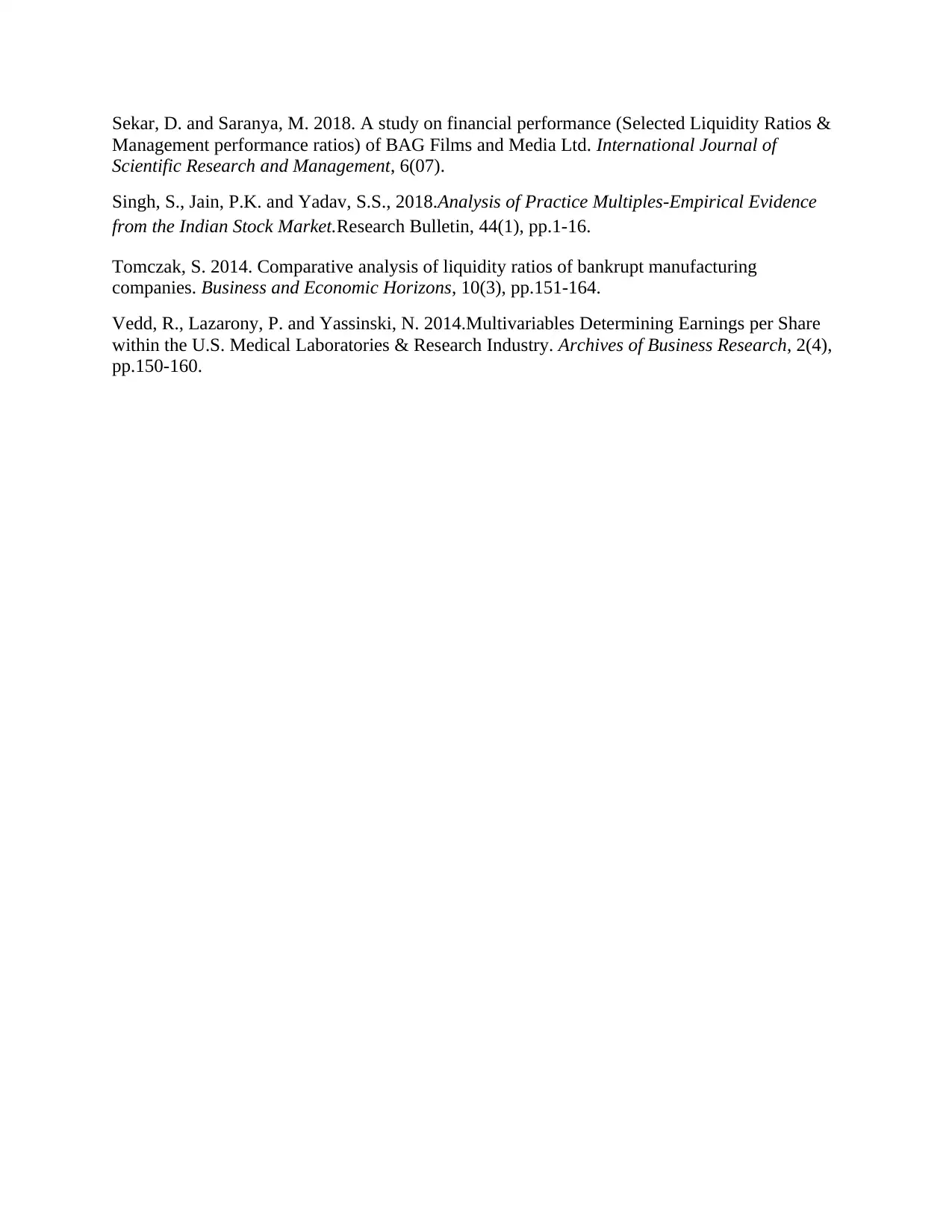
Sekar, D. and Saranya, M. 2018. A study on financial performance (Selected Liquidity Ratios &
Management performance ratios) of BAG Films and Media Ltd. International Journal of
Scientific Research and Management, 6(07).
Singh, S., Jain, P.K. and Yadav, S.S., 2018.Analysis of Practice Multiples-Empirical Evidence
from the Indian Stock Market.Research Bulletin, 44(1), pp.1-16.
Tomczak, S. 2014. Comparative analysis of liquidity ratios of bankrupt manufacturing
companies. Business and Economic Horizons, 10(3), pp.151-164.
Vedd, R., Lazarony, P. and Yassinski, N. 2014.Multivariables Determining Earnings per Share
within the U.S. Medical Laboratories & Research Industry. Archives of Business Research, 2(4),
pp.150-160.
Management performance ratios) of BAG Films and Media Ltd. International Journal of
Scientific Research and Management, 6(07).
Singh, S., Jain, P.K. and Yadav, S.S., 2018.Analysis of Practice Multiples-Empirical Evidence
from the Indian Stock Market.Research Bulletin, 44(1), pp.1-16.
Tomczak, S. 2014. Comparative analysis of liquidity ratios of bankrupt manufacturing
companies. Business and Economic Horizons, 10(3), pp.151-164.
Vedd, R., Lazarony, P. and Yassinski, N. 2014.Multivariables Determining Earnings per Share
within the U.S. Medical Laboratories & Research Industry. Archives of Business Research, 2(4),
pp.150-160.
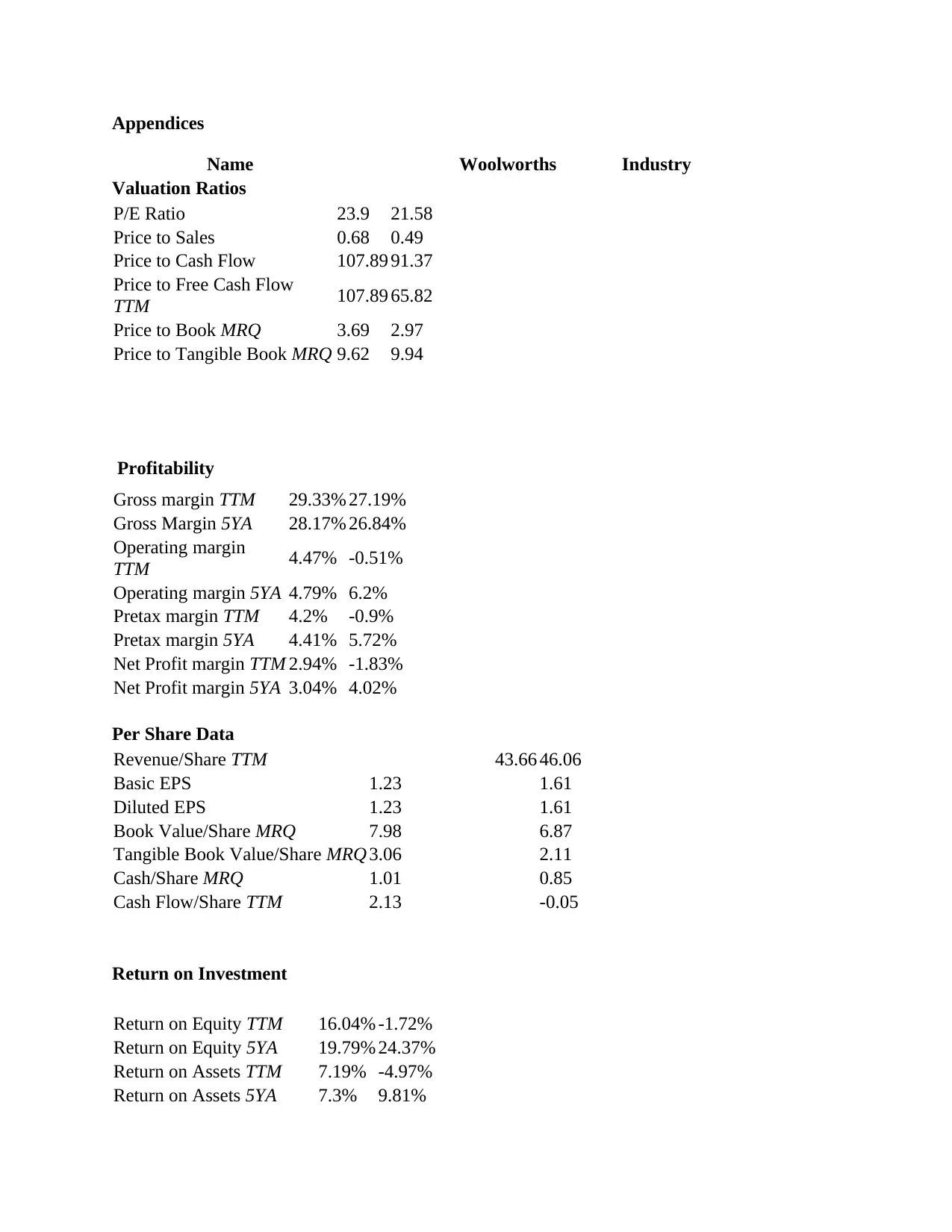
Appendices
Name Woolworths Industry
Valuation Ratios
P/E Ratio 23.9 21.58
Price to Sales 0.68 0.49
Price to Cash Flow 107.89 91.37
Price to Free Cash Flow
TTM 107.89 65.82
Price to Book MRQ 3.69 2.97
Price to Tangible Book MRQ 9.62 9.94
Profitability
Gross margin TTM 29.33% 27.19%
Gross Margin 5YA 28.17% 26.84%
Operating margin
TTM 4.47% -0.51%
Operating margin 5YA 4.79% 6.2%
Pretax margin TTM 4.2% -0.9%
Pretax margin 5YA 4.41% 5.72%
Net Profit margin TTM 2.94% -1.83%
Net Profit margin 5YA 3.04% 4.02%
Per Share Data
Revenue/Share TTM 43.66 46.06
Basic EPS 1.23 1.61
Diluted EPS 1.23 1.61
Book Value/Share MRQ 7.98 6.87
Tangible Book Value/Share MRQ 3.06 2.11
Cash/Share MRQ 1.01 0.85
Cash Flow/Share TTM 2.13 -0.05
Return on Investment
Return on Equity TTM 16.04% -1.72%
Return on Equity 5YA 19.79% 24.37%
Return on Assets TTM 7.19% -4.97%
Return on Assets 5YA 7.3% 9.81%
Name Woolworths Industry
Valuation Ratios
P/E Ratio 23.9 21.58
Price to Sales 0.68 0.49
Price to Cash Flow 107.89 91.37
Price to Free Cash Flow
TTM 107.89 65.82
Price to Book MRQ 3.69 2.97
Price to Tangible Book MRQ 9.62 9.94
Profitability
Gross margin TTM 29.33% 27.19%
Gross Margin 5YA 28.17% 26.84%
Operating margin
TTM 4.47% -0.51%
Operating margin 5YA 4.79% 6.2%
Pretax margin TTM 4.2% -0.9%
Pretax margin 5YA 4.41% 5.72%
Net Profit margin TTM 2.94% -1.83%
Net Profit margin 5YA 3.04% 4.02%
Per Share Data
Revenue/Share TTM 43.66 46.06
Basic EPS 1.23 1.61
Diluted EPS 1.23 1.61
Book Value/Share MRQ 7.98 6.87
Tangible Book Value/Share MRQ 3.06 2.11
Cash/Share MRQ 1.01 0.85
Cash Flow/Share TTM 2.13 -0.05
Return on Investment
Return on Equity TTM 16.04% -1.72%
Return on Equity 5YA 19.79% 24.37%
Return on Assets TTM 7.19% -4.97%
Return on Assets 5YA 7.3% 9.81%
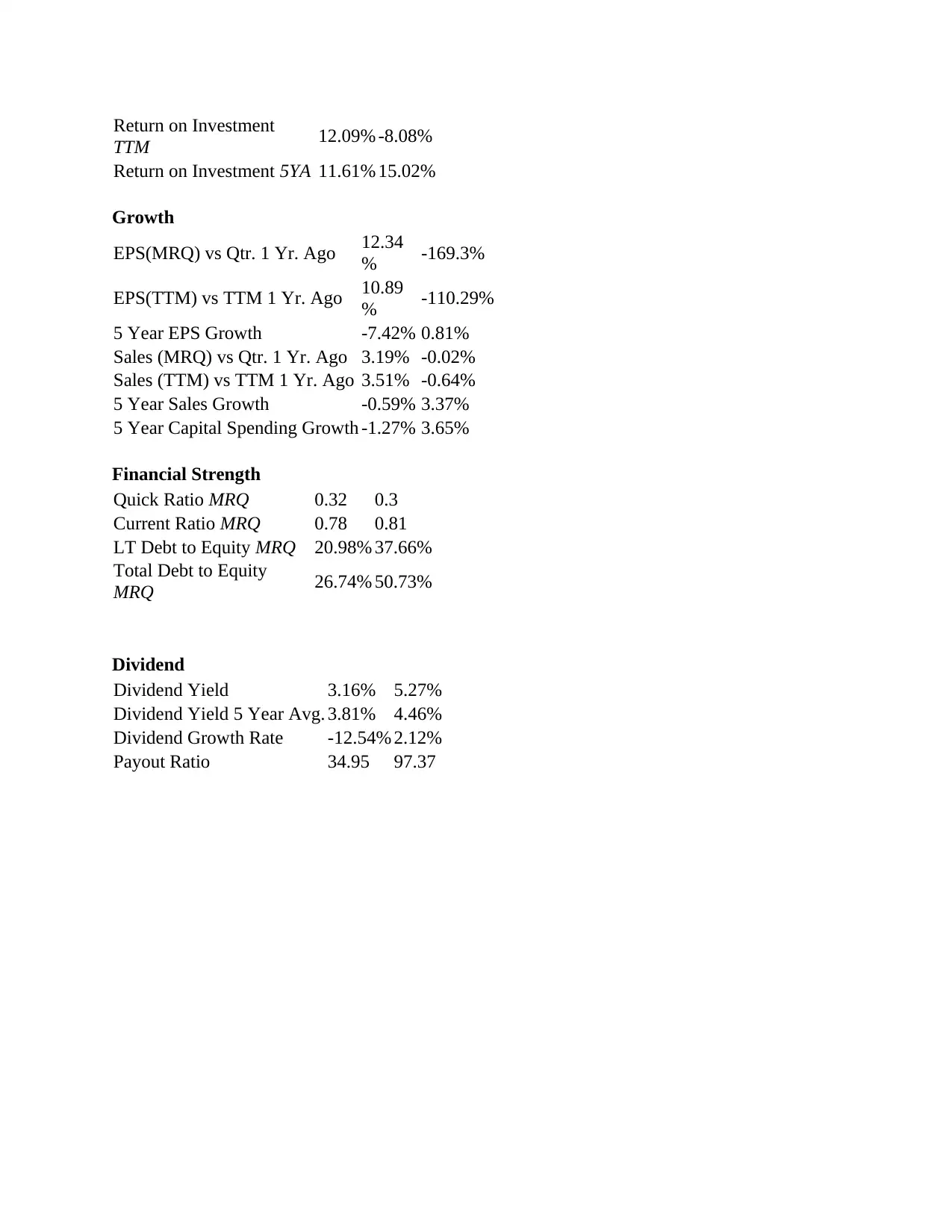
Return on Investment
TTM 12.09% -8.08%
Return on Investment 5YA 11.61% 15.02%
Growth
EPS(MRQ) vs Qtr. 1 Yr. Ago 12.34
% -169.3%
EPS(TTM) vs TTM 1 Yr. Ago 10.89
% -110.29%
5 Year EPS Growth -7.42% 0.81%
Sales (MRQ) vs Qtr. 1 Yr. Ago 3.19% -0.02%
Sales (TTM) vs TTM 1 Yr. Ago 3.51% -0.64%
5 Year Sales Growth -0.59% 3.37%
5 Year Capital Spending Growth -1.27% 3.65%
Financial Strength
Quick Ratio MRQ 0.32 0.3
Current Ratio MRQ 0.78 0.81
LT Debt to Equity MRQ 20.98% 37.66%
Total Debt to Equity
MRQ 26.74% 50.73%
Dividend
Dividend Yield 3.16% 5.27%
Dividend Yield 5 Year Avg. 3.81% 4.46%
Dividend Growth Rate -12.54% 2.12%
Payout Ratio 34.95 97.37
TTM 12.09% -8.08%
Return on Investment 5YA 11.61% 15.02%
Growth
EPS(MRQ) vs Qtr. 1 Yr. Ago 12.34
% -169.3%
EPS(TTM) vs TTM 1 Yr. Ago 10.89
% -110.29%
5 Year EPS Growth -7.42% 0.81%
Sales (MRQ) vs Qtr. 1 Yr. Ago 3.19% -0.02%
Sales (TTM) vs TTM 1 Yr. Ago 3.51% -0.64%
5 Year Sales Growth -0.59% 3.37%
5 Year Capital Spending Growth -1.27% 3.65%
Financial Strength
Quick Ratio MRQ 0.32 0.3
Current Ratio MRQ 0.78 0.81
LT Debt to Equity MRQ 20.98% 37.66%
Total Debt to Equity
MRQ 26.74% 50.73%
Dividend
Dividend Yield 3.16% 5.27%
Dividend Yield 5 Year Avg. 3.81% 4.46%
Dividend Growth Rate -12.54% 2.12%
Payout Ratio 34.95 97.37
1 out of 22
Related Documents
Your All-in-One AI-Powered Toolkit for Academic Success.
+13062052269
info@desklib.com
Available 24*7 on WhatsApp / Email
![[object Object]](/_next/static/media/star-bottom.7253800d.svg)
Unlock your academic potential
© 2024 | Zucol Services PVT LTD | All rights reserved.




